
- •Table of Contents
- •C# and the .NET Platform, Second Edition
- •Introduction
- •Part One: Introducing C# and the .NET Platform
- •Part Two: The C# Programming Language
- •Part Three: Programming with .NET Assemblies
- •Part Four: Leveraging the .NET Libraries
- •Part Five: Web Applications and XML Web Services
- •Obtaining This Book's Source Code
- •The .NET Solution
- •What C# Brings to the Table
- •The Role of the Assembly Manifest
- •Summary
- •Chapter 2: Building C# Applications
- •Summary
- •Chapter 3: C# Language Fundamentals
- •Defining Program Constants
- •Defining Custom Class Methods
- •C# Enumerations
- •Summary
- •The Second Pillar: C#'s Inheritance Support
- •Summary
- •Catching Exceptions
- •Finalizing a Type
- •Garbage Collection Optimizations
- •Summary
- •Chapter 6: Interfaces and Collections
- •Building Comparable Objects (IComparable)
- •Summary
- •Summary
- •Internal Representation of Type Indexers
- •Summary
- •An Overview of .NET Assemblies
- •Understanding Delayed Signing
- •Using a Shared Assembly
- •GAC Internals
- •Summary
- •Spawning Secondary Threads
- •A More Elaborate Threading Example
- •Summary
- •Summary
- •Object Persistence in the .NET Framework
- •The .NET Remoting Namespaces
- •Understanding the .NET Remoting Framework
- •All Together Now!
- •Terms of the .NET Remoting Trade
- •Testing the Remoting Application
- •Revisiting the Activation Mode of WKO Types
- •Deploying the Server to a Remote Machine
- •Summary
- •Control Events
- •The Form Class
- •Summary
- •Regarding the Disposal of System.Drawing Types
- •Understanding the Graphics Class
- •Summary
- •The TextBox Control
- •Working with Panel Controls
- •Configuring a Control's Anchoring Behavior
- •Summary
- •Chapter 16: The System.IO Namespace
- •The Static Members of the Directory Class
- •The Abstract Stream Class
- •Summary
- •The Role of ADO.NET Data Providers
- •The Types of System.Data
- •Selecting a Data Provider
- •The Types of the System.Data.OleDb Namespace
- •Working with the OleDbDataReader
- •Summary
- •Submitting the Form Data (GET and POST)
- •Some Benefits of ASP.NET
- •Creating an ASP.NET Web Application by Hand
- •The Composition of an ASP.NET Page
- •The Derivation of an ASP.NET Page

The Types of System.Data |
|
C# and the .NET Pla form, Second Edition |
|
by Andrew Troelsen |
ISBN:1590590554 |
Of all the ADO.NET namespaces, System.Data is the lowest common denominator. You simply cannot
Apress © 2003 (1200 pages)
build ADO.NET applications without specifying this namespace in your data access applications. This
This comprehensive text starts with a brief overview of the
namespace containsC# languagetypes thatndarethensharedquicklyamongmovesalltoADOkey.NETtechnicdatal andproviders, regardless of the underlying data storearchitectural. In a nutshell,i sues Systemfor .NET.Datadeveloperscontains. types that represent the data you obtain from a
data store, but not the types that make the literal connection. In addition to a number of database-centric exceptions (NoNullAllowedException, RowNotInTableException, MissingPrimaryKeyException, and the
Table of Contents
like), these types are little more than OO representations of common database primitives (tables, rows,
C# and the .NET Platform, Second Edition
columns, constraints, and so on). Table 17-2 lists some of the core types, grouped by related functionality.
Introduction
Part One - Introducing C# and the .NET Platform |
|||||||
|
Table 17-2: Key Members of the System.Data Namespace |
||||||
|
|
|
|
|
|
|
|
|
|
Chapter 1 |
- The Philosophy |
of .NET |
|
||
|
ChapterSystem.Data2 - BuildingTypeC# ApplicationsMeaning in Life |
|
|
||||
|
|
|
|
|
|
||
Part Two - The C# Programming |
|
Language |
|
|
|||
|
|
DataColumnCollection |
|
DataColumnCollection is used to represent all of the columns used by |
|
|
|
Chapter 3 |
- C# Language |
|
Fundamentals |
|
|
||
|
|
DataColumn |
|
a given DataTable.DataColumn represents a specific column in a |
|
|
|
Chapter 4 |
- Object-Oriented |
|
Programming with C# |
|
|
||
|
|
|
|
|
DataTable. |
|
|
|
|
|
|
|
|
|
|
|
|
Chapter 5 |
- Exceptions and |
|
Object Lifetime |
|
|
|
|
ConstraintCollection |
|
The ConstraintCollection represents all constraints (foreign key |
|
|
|
|
Chapter 6 |
- Interfaces and |
|
Collections |
|
|
|
|
|
|
|
|
constrains, unique constraints) assigned to a given DataTable. |
|
|
|
ChapterConstraint7 - Callback Interfaces, Delegates, and Events |
|
|
||||
|
Chapter 8 |
- Advanced C# TypeConstraintConstructionrepresentsTechniquesan OO wrapper around a single constraint |
|
|
|||
Part Three - Programming withassigned.NET Assembliesto one or more DataColumns. |
|
|
|||||
|
|
|
|
|
|
|
|
|
|
Chapter 9 |
- Understanding |
|
.NET Assemblies |
|
|
|
|
DataRowCollection |
|
These types represent a collection of rows for a DataTable |
|
|
|
|
Chapter 10 |
- Processes, AppDomains, Contexts, and Threads |
|
|
|||
|
|
DataRow |
|
(DataRowCollection) and a specific row of data in a DataTable |
|
|
|
|
Chapter 11 |
- Type Reflection, Late Binding, and Attribute-Based Programming |
|
|
|||
|
|
|
|
|
(DataRow). |
|
|
|
|
|
|
|
|
||
Part Four - Leveraging the .NET Libraries |
|
|
|||||
|
|
DataRowView |
|
DataRowView allows you to carve out a predefined "view" from an |
|
|
|
Chapter 12 |
- Object Serialization and the .NET Remoting Layer |
|
|
||||
|
|
|
|
|
existing row. |
|
|
ChapterDataView13 - Building a Better Window (Introducing Windows Forms) |
|
|
|||||
Chapter 14 |
- A Better Painting TheFrameworkDataView(GDI+)type represents a customized view of a DataTable that |
|
|
||||
|
Chapter 15 |
- Programming withcanWindowsbe usedFormsfor sorting,Controlsfiltering, searching, editing, and navigation. |
|
|
|||
|
|
|
|
|
|
|
|
|
|
Chapter 16 |
- The System.IO |
|
Namespace |
|
|
|
|
DataSet |
|
|
Represents an in-memory cache of data that may consist of multiple |
|
|
|
Chapter 17 |
- Data Access with |
ADO.NET |
|
|
||
|
|
|
|
|
related DataTables. |
|
|
Part Five - Web Applications |
|
and XML Web Services |
|
|
|||
|
|||||||
|
|
ForeignKeyConstraint |
|
ForeignKeyConstraint represents an action restriction enforced on a |
|
|
|
Chapter 18 |
- ASP.NET Web |
Pages and Web Controls |
|
|
|||
ChapterUniqueConstraint19 - ASP.NET Web |
|
set of columns in a primary key/foreign key relationship. |
|
|
|||
Applications |
|
|
|||||
Chapter 20 |
- XML Web ServicesThe UniqueConstraint type represents a restriction on a set of columns |
|
|
||||
Index |
|
|
in which all values must be unique. |
|
|
||
|
|
|
|
|
|
|
|
List of Figures
DataRelationCollection
List of Tables
DataRelation
DataTableCollection
DataTable
This collection represents all relationships (e.g., DataRelation types) between the tables in a DataSet.
The DataTableCollection type represents all of tables (e.g., DataTable types) for a particular DataSet.
To get the ball rolling, the first half of this chapter discusses how to manipulate these items by hand. Once you understand how to build a DataSet in the raw, you should have no problem manipulating a DataSet populated by a data provider using a related data adapter. Just as importantly, once you understand how to manually create and tweak a DataSet by hand, you will have no problems altering the wizard-generated code of VS .NET.

ExaminingC#theandDataColumnthe .NET Platform,TypeSecond Edition
by Andrew Troelsen |
ISBN:1590590554 |
The DataColumn type represents a single column maintained by a DataTable. Collectively speaking, the
Apress © 2003 (1200 pages)
set of all DataColumn types bound to a given DataTable represents the foundation of a table's schema
This comprehensive text starts with a brief overview of the
information. For example,C# languageassumeand thenyouquicklyhave amovtablesnamedto k y technicalEmployeesandwith three columns (EmpID, FirstName, and LastName)architectural. Programmatically,issues for .NET developersyou would. use three ADO.NET DataColumn objects to represent them in memory. As you will see in just a moment, the DataTable type maintains an internal collection (which is accessed using the Columns property) to maintain its DataColumn types.
Table of Contents
C#If youandhavethe .NETa backgroundPlatform, Secondin relationalEditiondatabase theory, you know that a given column in a data table can
be assigned a set of constraints (e.g., configured as a primary key, assigned a default value, configured to
Introduction
contain read-only information, and so on). Also, every column in a table must map to an underlying data
Part One - Introducing C# and the .NET Platform
type (int, varchar, and so forth). For example, the Employees table's schema may demand that the EmpID
Chapter 1 - The Philosophy of .NET
column maps to an integer, while FirstName and LastName map to an array of characters. The
Chapter 2 - Building C# Applications
DataColumn class has numerous properties that allow you to configure these very things. Table 17-3
Part Two - The C# Programming Language
provides a rundown of some core properties.
Chapter 3 - C# Language Fundamentals
Chapter 4 - Object-Oriented Programming with C#
Table 17-3: Properties of the DataColumn |
|||||||
|
Chapter 5 - Exceptions and Object Lifetime |
||||||
|
Chapter 6 |
- Interfaces and |
|
|
Collect ons |
|
|
|
DataColumn |
|
|
Meaning in Life |
|
|
|
|
Chapter 7 |
- Callback Interfaces, Delegates, and Events |
|
|
|||
|
Property |
|
|
|
|
|
|
|
|
|
|
|
|
|
|
|
Chapter 8 |
- Advanced C# |
|
Type Construction Techniques |
|
||
|
AllowDBNull |
|
|
Used to indicate if a row can specify null values in this column. The |
|
|
|
Part Three - Programming |
|
|
with .NET Assemblies |
|
|
||
|
|
|
|
|
default value is true. |
|
|
|
Chapter 9 |
- Understanding |
|
|
.NET Assemblies |
|
|
|
|
||||||
ChapterAutoIncrement10 - Processes, AppDomains,These propertiesContexts,areandusedThreadsto configure the auto-increment behavior for
Chapter 11 - Type Reflection,aLategivenBinding,columnand. ThisAttributecan be-BasedhelpfulProgrammingwhen you wish to ensure unique AutoIncrementSeed
Part Four - Leveraging the .NETvaluesLibrariesin given DataColumn (such as a primary key). By default, a
AutoIncrementStep
Chapter 12 - Object SerializationDataColumnand the .NETdoesRemotingnot supportLayerauto-incrementation.
|
|
|
|
|
|
Chapter 13 - Building a Better Window (Introducing Windows Forms) |
|
||
|
Caption |
|
Gets or sets the caption to be displayed for this column (for example, |
|
|
Chapter 14 - A Better Painting Framework (GDI+) |
|
||
|
|
|
what the end user sees in a DataGrid). |
|
|
Chapter 15 - Programming |
|
with Windows Forms Controls |
|
|
|
|
||
|
ChapterColumnMapping16 - The System.IO |
|
ThisNamespaceproperty determines how a DataColumn is represented when a |
|
|
Chapter 17 - Data Access withDataSetADO.NETis saved as an XML document using the DataSet.WriteXml() |
|
||
Part Five - Web Applications |
|
method.and XML Web Services |
|
|
|
|
|
|
|
|
Chapter 18 - ASP.NET Web |
|
Pages and Web Controls |
|
|
ColumnName |
|
Gets or sets the name of the column in the Columns collection (meaning |
|
|
Chapter 19 - ASP.NET Web |
|
Applications |
|
|
|
|
how it is represented internally by the DataTable). If you do not set the |
|
|
Chapter 20 - XML Web Services |
|
||
Index |
|
ColumnName explicitly, the default values are Column with (n+1) |
|
|
|
numerical suffixes (i.e., Column1, Column2, Column3, and so forth). |
|
||
|
|
|
|
|
List of Figures |
|
Defines the data type (Boolean, string, float, and so on) stored in the |
|
|
|
DataType |
|
|
|
List of Tables |
|
column. |
|
|
|
|
|
|
|
|
|
|
|
|
|
DefaultValue |
|
Gets or sets the default value assigned to this column when inserting |
|
|
|
|
new rows. This is used if not otherwise specified. |
|
|
|
|
|
|
|
Expression |
|
Gets or sets the expression used to filter rows, calculate a column's |
|
|
|
|
value, or create an aggregate column. |
|
|
|
|
|
|
|
Ordinal |
|
Gets the numerical position of the column in the Columns collection |
|
|
|
|
maintained by the DataTable. |
|
|
|
|
|
|
|
ReadOnly |
|
Determines if this column can be modified once a row has been added |
|
|
|
|
to the table. The default is false. |
|
|
|
|
|
|
|
Table |
|
Gets the DataTable that contains this DataColumn. |
|

|
Unique |
C# and |
|
theGets.NETor setsPlatform,a valueSecondindicatingEditionwhether the values in each row of the |
|
|
|
|
by Andrew |
column must be unique or if repeating values are permissible. If a |
|
||
|
|
Troelsen |
ISBN:1590590554 |
|
||
|
|
Apress © |
column is assigned a primary key constraint, the Unique property should |
|
||
|
|
2003 (1200 pages) |
|
|
||
|
|
|
|
be set to true. |
|
|
|
|
This comprehensive text starts with a brief overview of the |
|
|||
|
|
C# language and then quickly moves to key technical and |
||||
|
|
architectural issues for .NET developers. |
|
|
||
Building a DataColumn
Table of Contents
To illustrate the basic use of the DataColumn, assume you need to model a column named FirstName,
C# and the .NET Platform, Second Edition
which internally maps to an array of characters. For the sake of argument, let's say this column (for
Introduction
whatever reason) must be read-only. Assuming you wish to build your DataColumn in the Click event
Part One - Introducing C# and the .NET Platform
handler of a Button type within a Windows Forms application, you would write the following logic:
Chapter 1 - The Philosophy of .NET
Chapter 2 - Building C# Applications
protected void btnColumn_Click (object sender, System.EventArgs e)
Part Two - The C# Programming Language
{
Chapter 3 - C# Language Fundamentals
// Build the FirstName column.
Chapter 4 - Object-Oriented Programming with C#
DataColumn colFName = new DataColumn();
Chapter 5 - Exceptions and Object Lifetime
// Set a bunch of values.
Chapter 6 - Interfaces and Collections
colFName.DataType = Type.GetType("System.String");
Chapter 7 - Callback Interfaces, Delegates, and Events
colFName.ReadOnly = true;
Chapter colFName8 - Advanced.CaptionC# Type =Construction"First Name";Techniques
Part ThreecolFName- Programming.ColumnNamewith .NET =Assemblies"FirstName";
Chapter //9 -DisplayUnderstandingDataColumn's.NET Assembliesvalues.
Chapter string10 - Processes,temp AppDomains,= "ColumnContexts,type: and" +ThreadscolFName.DataType + "\n" +
"Read only? " + colFName.ReadOnly + "\n" +
Chapter 11 - Type Reflection, Late Binding, and Attribute-B sed Programming
"Caption: " + colFName.Caption + "\n" +
Part Four - Leveraging the .NET Libraries
"Column Name: " + colFName.ColumnName + "\n" +
Chapter 12 - Object Serialization and the .NET Remoting Layer
"Nulls allowed? " + colFName.AllowDBNull;
Chapter 13 - Building a Better Window (Introducing Windows Forms)
MessageBox.Show(temp, "Column properties");
Chapter 14 - A Better Painting Framework (GDI+)
}
Chapter 15 - Programming with Windows Forms Controls Chapter 16 - The System.IO Namespace
Chapter 17 - Data Access with ADO.NET
This gives the result shown in Figure 17-2.
Part Five - Web Applications and XML Web Services
Chapter 18 - ASP.NET Web Pages and Web Controls
Chapter
Chapter
Index
List of
List of
Figure 17-2: Exercising a DataColumn type
Do be aware that the DataColumn provides several overloaded constructors. Given this, you can specify a number of characteristics directly at the time of creation (as opposed to discrete properties), as shown here:
// Build the FirstName column (take two).
DataColumn colFName = new DataColumn("FirstName",
Type.GetType("System.String"));
colFName.ReadOnly = true;

colFName.Caption = "First Name";
C# and the .NET Platform, Second Edition |
|
by Andrew Troelsen |
ISBN:1590590554 |
Apress © 2003 (1200 pages) |
|
Adding a DataColumn to a DataTable
This comprehensive text starts with a brief overview of the
C# language and then quickly moves to key technical and
The DataColumn type does not typically exist as a stand-alone entity, but is instead inserted into a related architectural issues for .NET developers.
DataTable. To illustrate, create a new DataTable type (fully detailed later in the chapter). Next, insert each DataColumn in the DataTable.DataColumnCollection type using the Columns property. Here is an
Tableexample:of Contents
C# and the .NET Platform, Second Edition
Introduct// Buildon the FirstName column.
PartDataColumnOne - IntroducingmyColumnC# and=thenew.NETDataColumn();Platform
Chapter... 1 - The Philosophy of .NET
Chapter// Create2 - Buildinga newC#DataTableApplic tions.
PartDataTableTwo - The C#myTableProgrammi= newg LanguageDataTable("MyTable");
// The Columns property returns a DataColumnCollection type.
Chapter 3 - C# Language Fundamentals
// Use the Add() method to insert the column in the table.
Chapter 4 - Object-Oriented Programming with C#
myTable.Columns.Add(myColumn);
Chapter 5 - Exceptions and Object Lifetime Chapter 6 - Interfaces and Collections
Chapter 7 - Callback Interfaces, Delegates, and Events
ChapterConfiguring8 - Advanceda C#DataColumnType nstructiontoTechniquesFunction As a Primary Key
Part Three - Programming with .NET Assemblies
One common rule of database development is that a table should have at least one column that functions
Chapter 9 - Understanding .NET Assemblies
as the primary key. A primary key constraint is used to uniquely identify a record (row) in a given table. In
Chapter 10 - Processes, AppDomains, Contexts, and Threads
keeping with the current Employees example, assume you now wish to build a new DataColumn type to
Chapter 11 - Type Reflection, Late Binding, and Attribute-Based Programming
represent the EmpID field. This column will be the primary key of the table and thus should have the
Part Four - Leveraging the .NET Libraries
AllowDBNull and Unique properties configured as shown here:
Chapter 12 - Object Serialization and the .NET Remoting Layer
Chapter 13 - Building a Better Window (Introducing Windows Forms)
// This column is functioning as a primary key.
Chapter 14 - A Better Painting Framework (GDI+)
DataColumn colEmpID = new DataColumn(EmpID, Type.GetType("System.Int32"));
Chapter 15 - Programming with Windows Forms Controls
colEmpID.Caption = "Employee ID";
Chapter 16 - The System.IO Namespace
colEmpID.AllowDBNull = false;
Chapter 17 - Data Access with ADO.NET
colEmpID.Unique = true;
Part Five - Web Applications and XML Web Services
Chapter 18 - ASP.NET Web Pages and Web Controls
Chapter 19 - ASP.NET Web Applications
Once the DataColumn has been correctly set up to function as a primary key, the next step is to assign this
Chapter 20 - XML Web Services
DataColumn to the DataTable's PrimaryKey property. You will see how to do in just a bit during the Indexdiscussion of the DataTable, so put this on the back burner for the time being.
List of Figures
List of Tables
Enabling Auto-Incrementing Fields
One aspect of the DataColumn you may choose to configure is its ability to autoincrement. Simply put, auto-incrementing columns are used to ensure that when a new row is added to a given table, the value of this column is assigned automatically, based on the current step of the incrementation. This can be helpful when you wish to ensure that a column has no repeating values (such as a primary key). This behavior is controlled using the AutoIncrement, AutoIncrementSeed, and AutoIncrementStep properties.
To illustrate, build a DataColumn that supports auto-incrementation. The seed value is used to mark the starting value of the column, where the step value identifies the number to add to the seed when incrementing, as shown here:
// Create a data column.
DataColumn myColumn = new DataColumn();
myColumn.ColumnName = "Foo";
myColumn.DataType = System.Type.GetType("System.Int32");

// Set the auto-increment behavior.
C# and the .NET Platform, Second Edition myColumn.AutoIncrement = true;
by Andrew Troelsen |
= |
500; |
ISBN:1590590554 |
myColumn.AutoIncrementSeed |
|
||
Apress © 2003 (1200 pages) |
|
||
myColumn.AutoIncrementStep |
= |
12; |
|
This comprehensive text starts with a brief overview of the
C# language and then quickly moves to key technical and
architectural issues for .NET developers.
Here, the Foo column has been configured to ensure that as rows are added to the respective table, the value in this field is incremented by 12. Because the seed has been set at 500, the first five values should
be 500, 512, 524, 536, and 548.
Table of Contents
C#Toandprovethethe.NETpoint,Platform,insertSecondthis DataColumnEditi n in a DataTable. Then add a number of new rows to the table,
Introductionwhich of course automatically bumps the value in the Foo column, as shown here:
Part One - Introducing C# and the .NET Platform
Chapter 1 - The Philosophy of .NET
protected void btnAutoCol_Click (object sender, System.EventArgs e)
Chapter 2 - Building C# Applications
{
Part Two - The C# Programming Language
// Make a data column that maps to an int.
Chapter 3 - C# Language Fundamentals
DataColumn myColumn = new DataColumn();
Chapter myColumn4 - Object.-OrientedColumnNameProgramming= "Foo";with C#
Chapter myColumn5 - Exceptions.DataTypeand Object= LifetimeSyst m.Type.GetType("System.Int32");
Chapter //6 -SetIn erfacthes autond Collections-increment behavior.
myColumn.AutoIncrementerfaces, = true; Chapter 7 - Callback Delegates, and Events
myColumn.AutoIncrementSeed = 500;
Chapter 8 - Advanced C# Type Construction Techniques
myColumn.AutoIncrementStep = 12;
Part Three - Programming with .NET Assemblies
// Add this column to a new DataTable.
Chapter 9 - Understanding .NET Assemblies
DataTable myTable = new DataTable("MyTable");
Chapter 10 - Processes, AppDomains, Contexts, and Threads
myTable.Columns.Add(myColumn);
Chapter 11 - Type Reflection, Late Binding, and Attribute-Based Programming
// Add 20 new rows.
Part Four - Leveraging the .NET Libraries
DataRow r;
Chapter 12 - Object Serialization and the .NET Remoting Layer for(int i =0; i < 20; i++)
Chapter 13 - Building a Better Window (Introducing Windows Forms)
{
Chapter 14 - A Better Painting Framework (GDI+) r = myTable.NewRow();
Chapter 15 - Programming with Windows Forms Controls myTable.Rows.Add(r);
Chapter 16 - The System.IO Namespace
}
Chapter 17 - Data Access with ADO.NET
// Now list the value in each row.
Part Five - Web Applications and XML Web Services
string temp = "";
Chapter 18 - ASP.NET Web Pages and Web Controls
DataRowCollection rows = myTable.Rows;
Chapter 19 - ASP.NET Web Applications
for(int i = 0;i < myTable.Rows.Count; i++)
Chapter {20 - XML Web Services
Index DataRow currRow = rows[i];
List of Figures temp += currRow["Foo"] + " ";
}
List of Tables
MessageBox.Show(temp, "These values brought ala auto-increment");
}
If you run the application (and click the corresponding Button), you see the message shown in Figure 17-3.
Figure 17-3: Auto-incrementation of a DataColumn
Configuring a Column's XML Data Representation

While many of the remaining DataColumn properties are rather self-explanatory (provided you are
C# and the .NET Platform, Second Edition |
|
comfortable with database terminology), I would like to discuss the ColumnMapping property. The |
|
by Andrew Troelsen |
ISBN:1590590554 |
DataColumn.ColumnMapping property is used to configure how this column should be represented in
Apress © 2003 (1200 pages)
XML, if the owning DataSet dumps its contents using the WriteXml() method. The value of the
This compreheconfiguredsive textusingtarts with a brief overview of the
ColumnMapping property is the MappingType enumeration (Table 17-4).
C# language and then quickly moves to key technical and
architectural issues for .NET developers.
Table 17-4: Values of the MappingType Enumeration
|
|
|
|
|
|
|
MappingType Enumeration |
|
Meaning in Life |
|
|
Table of Contents |
|
|
|
||
|
Value |
|
|
|
|
C# and the .NET Platform, Second Edition |
|
|
|
||
|
|
|
|||
IntroductionAttribute |
|
The column is mapped to an XML attribute. |
|
||
|
|
|
|
|
|
Part One - Introducing C# and the .NET Platform |
|
||||
|
Element |
|
The column is mapped to an XML element (the |
|
|
Chapter 1 |
- The Philosophy of .NET |
|
default). |
|
|
|
|
|
|
|
|
|
Chapter 2 - Building C# Applications |
|
|
|
|
|
|
|
|
||
PartHiddenTwo - The C# Programming Language |
|
The column is mapped to an internal structure. |
|
||
|
|
|
|
|
|
|
Chapter 3 - C# Language Fundamentals |
|
The column is mapped to text. |
|
|
|
SimpleContent |
|
|
||
|
Chapter 4 |
- Object-Oriented Programming with C# |
|||
Chapter 5 |
- Exceptions and Object Lifetime |
|
|
|
|
The default value of the ColumnMapping property is MappingType.Element. Assume that you have |
|||||
Chapter 6 |
- Interfaces and Collections |
|
|
|
|
instructed the owning DataSet to write its contents to a new file stream as XML. Using this default setting,
Chapter 7 - Callback Interfaces, Delegates, and Events the EmpID column would appear as shown here:
Chapter 8 - Advanced C# Type Construction Techniques
Part Three - Programming with .NET Assemblies
<Employee>
Chapter 9 - Understanding .NET Assemblies
<EmpID>500</EmpID>
Chapter 10 - Processes, AppDomains, Contexts, and Threads
</Employee>
Chapter 11 - Type Reflection, Late Binding, and Attribute-Based Programming
Part Four - Leveraging the .NET Libraries
ChaptHowever,r 12 if- theObjectDataColumn'sSerializationColumnMappingand the .NET RemotingpropertyLayeris set to MappingType.Attribute, you see the
following XML representation:
Chapter 13 - Building Better Window (Introducing Windows Forms) Chapter 14 - A Better Painting Framework (GDI+) Chapter<Employee15 - ProgrammingEmpID = "500"/>with Windows Forms Controls
Chapter 16 - The System.IO Namespace
Chapter 17 - Data Access with ADO.NET
This chapter examines the ADO.NET/XML integration in greater detail when discussing the DataSet.
Part Five - Web Applications and XML Web Services
Nevertheless, at this point, you understand how to create a stand-alone DataColumn type. Now for an
Chapter 18 - ASP.NET Web Pages and Web Controls
examination of the related DataRow type.
Chapter 19 - ASP.NET Web Applications
Chapter 20 - XML Web Services
SOURCE The DataColumn application is included under the Chapter 17 subdirectory.
IndexCODE
List of Figures
List of Tables

ExaminingC#theandDataRowthe .NET Platform,TypeSecond Edition
by Andrew Troelsen |
ISBN:1590590554 |
As you have seen, a collection of DataColumn objects represents the schema of a table. A DataTable
Apress © 2003 (1200 pages)
maintains its columns using the internal DataColumnCollection type. In contrast, a collection of DataRow
This comprehensive text starts with a brief overview of the
types representsC#thelactualngu gedataandinthenthe quicklytable. Thus,movesif toyoukeyhavetechnical20 listingsand in a table named Employees, you can representarchitecturalthese entriesis uesusingfor20.NETDataRowdeveloperstypes. . Using the members of the DataRow class, you are able to insert, remove, evaluate, and manipulate the values in the table.
TableWorkingof Conwithentsa DataRow is a bit different from working with a DataColumn, because you cannot create a C#directand instancethe .NET ofPlatform,this type,Secondbut ratherEditionobtain a reference from a given DataTable. For example, assume
you wish to insert a new row in the Employees table. The DataTable.NewRow() method allows you to
Introduction
obtain the next slot in the table, at which point you can fill each column with new data via the type indexer,
Part One - Introducing C# and the .NET Platform
as shown here:
Chapter 1 - The Philosophy of .NET
Chapter 2 - Building C# Applications
Part// TwoBuild- TheaC#newProgrTablemming. Language
ChDataTablepter 3 - C#empTableLanguage Fundament= new DataTable("Employees");ls
// Add EmpID, FirstName and LastName columns to table...
Chapter 4 - Object-Or ented Programming wi h C#
...
Chapter 5 - Exceptions and Object Lifetime
// Build a new Employee record.
Chapter 6 - Interfaces and Collections
DataRow row = empTable.NewRow();
Chapter 7 - Callback Interfaces, Delegates, and Events
row["EmpID"] = 102;
Chapter 8 - Advanced C# Type Construction Techniques
row["FirstName"] = "Joe";
Part Three - Programming with .NET Assemblies
row["LastName"] = "Blow";
Chapter 9 - Understanding .NET Assemblies
// Add it to the Table's DataRowCollection.
Chapter 10 - Processes, AppDomains, Contexts, and Threads empTable.Rows.Add(row);
Chapter 11 - Type Reflection, Late Binding, and Attribute-Based Programming
Part Four - Leveraging the .NET Libraries
Chapter 12 - Object Serialization and the .NET Remoting Layer
ChapterNotice 13how- theBuildingDataRowBetterclassWindowdefines(Introducingan indexerWindowsthat canForms)be used to gain access to a given DataColumn
|
by numerical positionas well as column name. Also notice that the DataTable maintains another internal |
||||||
Chapter 14 - A Better P inting Framework (GDI+) |
|||||||
Chaptercollection15 |
(DataRowCollection)- Programming with Windowsto hold Formseach rowControlsof data. The DataRow type defines the core members, |
||||||
Chaptergrouped16by- relatedThe Systemfunctionality,.IO Namespacein Table 17-5. |
|||||||
Chapter 17 |
- Data Access with ADO.NET |
||||||
PartTableFive17--Web5: KeyApplicationsMembersandof theXMLDataRowWeb ServicesType |
|||||||
|
|
|
|
|
|
|
|
|
|
Chapter 18 |
- ASP.NET Web |
|
Pages and Web Controls |
|
|
|
|
DataRow Member |
|
Meaning in Life |
|
||
|
|
Chapter 19 |
- ASP.NET Web |
|
Applications |
|
|
ChapterHasErrors20 - XML Web ServicesThe HasErrors property returns a Boolean value indicating if there are errors in a columns collection.
If so, the GetColumnsInError() method can be used to obtain the offending members, GetColumnError() can be used to obtain the error description, while the ClearErrors() method removes each error listing for the row.
The RowError property allows you to configure a textual description of the error for a given row.
This property gets or sets all of the values for this row using an array of objects.
This property is used to pinpoint the current "state" of the DataRow using values of the RowState enumeration.
Use this property to obtain a reference to the DataTable containing this
DataRow.
Commit (or reject) all the changes made to this row since the last time
AcceptChanges() was called.

BeginEdit()
EndEdit()
CancelEdit()
Begin, end, or cancel an edit operation on a DataRow object.
C# and the .NET Platform, Second Edition
by Andrew Troelsen |
ISBN:1590590554 |
Apress © 2003 (1200 pages)
|
Delete() |
This |
comprehensive text starts with a brief overview of the |
|
|
C# languageThisandmethodthen quicklymarksmovesthis rowtotokeybetechnicalremovedandwhen the AcceptChanges() |
|||
|
|
architectural issues for .NET developers. |
||
|
|
|
|
method is called. |
|
|
|
|
|
|
IsNull() |
|
|
Gets a value indicating whether the specified column contains a null |
Table of Contents |
|
|
value. |
|
|
|
|
|
|
C# and the .NET Platform, Second Edition
Introduction
PartUnderstandingOne - In roducing C#theand theDataRow.NET Platform.RowState Property
Chapter 1 - The Philosophy of .NET
ChapterMost of2the- methodsBuilding C#of Applicthe DataRowions class only make sense in the context of an owning DataTable. You Partwill Twosee the- TheprocessC# Programmingof inserting,Languageremoving, and updating rows in just a moment; first, however, you should
get to know the RowState property. This property is useful when you need to programmatically identify the
Chapter 3 - C# Language Fundamentals
set of all rows in a table that have changed, have been newly inserted, and so forth. This property may be
Chapter 4 - Object-Oriented Programming with C#
|
assigned any value from the DataRowState enumeration (Table 17-6). |
|||||||
Chapter 5 |
- Exceptions and Object Lifetime |
|||||||
Chapter 6 |
- Interfaces and Collections |
|||||||
|
Table 17-6: Values of the DataRowState Enumeration |
|||||||
|
Chapter 7 |
- Callback Interfaces, Delegates, and Events |
|
|||||
|
|
|
|
|
|
|
|
|
|
|
Chapter 8 |
- Advanced C# Type Construction Techniques |
|
|
|||
|
|
DataRowState |
|
|
Meaning in Life |
|
|
|
Part Three - Programming with .NET Assemblies |
|
|
||||||
|
|
Enumeration |
|
|
|
|
|
|
Chapter 9 |
- Understanding .NET Assemblies |
|
|
|||||
|
|
Value |
|
|
|
|
|
|
|
|
Chapter 10 |
- Processes, AppDomains, Contexts, and Threads |
|
|
|||
|
|
|
||||||
|
|
Added |
|
|
|
The row has been added to a DataRowCollection, and |
|
|
|
Chapter 11 |
- Type Reflection, Late Binding, and Attribute-Based Programming |
|
|
||||
|
|
|
|
|
|
AcceptChanges() has not been called. |
|
|
Part Four - Leveraging the .NET Libraries |
|
|
||||||
|
|
|
|
|
|
|
|
|
|
|
Chapter 12 |
- Object Serialization |
and the .NET Remoting Layer |
|
|
||
|
|
Deleted |
|
|
|
The row has been deleted, via the Delete() method of the DataRow. |
|
|
|
|
|
|
|
|
|
|
|
|
|
Chapter 13 |
- Building a Better |
|
Window (Introducing Windows Forms) |
|
||
|
|
Detached |
|
|
The row has been created but is not part of any DataRowCollection. A |
|
|
|
|
Chapter 14 |
- A Better Painting |
|
|
Framework (GDI+) |
|
|
|
|
|
Chapter 15 |
|
|
|
DataRow is in this state immediately after it has been created and |
|
|
|
- Programming with Windows Forms Controls |
|
|
|||||
|
|
Chapter 16 |
|
|
|
before it is added to a collection, or if it has been removed from a |
|
|
|
- The System.IO Namespace |
|
|
|||||
|
|
|
|
|
|
collection. |
|
|
|
|
Chapter 17 |
- Data Access with |
|
|
ADO.NET |
|
|
|
|
|
|
|
|
|||
PartModifiedFive - Web Applications |
|
|
andTheXMLrowWebhasServicesbeen modified, and AcceptChanges() has not been |
|
|
|||
Chapter 18 |
- ASP.NET Web Pagescalledand. Web Controls |
|
|
|||||
|
|
|
|
|
|
|
|
|
|
|
Chapter 19 |
- ASP.NET Web |
|
|
Applications |
|
|
|
|
Unchanged |
|
|
The row has not changed since AcceptChanges() was last called. |
|
|
|
|
|
Chapter 20 |
- XML Web Services |
|
|
|
||
Index
ListToofillustrateFigures the various states a DataRow may have, the following class documents the changes to the
ListRowStateof T blesproperty as a new DataRow is created, inserted in, and removed from a DataTable:
public class DRState
{
public static void Main()
{
Console.WriteLine("***** The RowState property *****");
// Build a single column DataTable
DataTable myTable = new DataTable("Employees");
DataColumn colID = new DataColumn("empID",
Type.GetType("System.Int32"));
myTable.Columns.Add(colID);
// The DataRow.
DataRow myRow;
// Create a new (detached) DataRow.
Console.WriteLine("Made new DataRow");

myRow = myTable.NewRow();
C# and the .NET Platform, Second Edition
Console.WriteLine("->Row state: {0}\n", myRow.RowState.ToString());
by Andrew Troelsen |
ISBN:1590590554 |
// Now add it to table. |
|
Apress © 2003 (1200 pages)
Console.WriteLine("Added DataRow to DataTable");
This comprehensive text starts with a brief overview of the myTable.Rows.Add(myRow);
C# language and then quickly moves to key technical and
Console.WriteLine("->Row state: {0}\n", myRow.RowState.ToString()); architectural issues for .NET developers.
// Trigger an accept.
Console.WriteLine("Called AcceptChanges() on DataTable");
myTable.AcceptChanges();
Table of Contents
Console.WriteLine("->Row state: {0}\n", myRow.RowState.ToString());
C# and the .NET Platform, Second Edition
Introduction |
// Modify it. |
DataRow"); |
|
Part One - IntroducingConsole.WriteLine("ModifiedC# and the .NET Platform |
|||
Chapter 1 |
|
myRow["empID"] = 100; |
|
- The Philosophy of .NET |
|
||
Chapter 2 |
|
Console.WriteLine("->Row state: {0}\n", myRow.RowState.ToString()); |
|
- Building C# Applications |
|
||
|
|
// Now delete it. |
|
Part Two - The C# Programming Language |
|
||
|
|
Console.WriteLine("Deleted DataRow"); |
|
Chapter 3 |
- C# Language Fundamentals |
|
|
|
|
myRow.Delete(); |
|
Chapter 4 |
- Object-Oriented Programming with C# |
|
|
|
|
Console.WriteLine("->Row state: {0}\n", myRow.RowState.ToString()); |
|
Chapter 5 - Exceptions and Object Lifetime |
|
||
|
|
myRow.AcceptChanges(); |
|
Chapter 6 - Interfaces and Collections |
|
||
} |
|
|
|
Chapter 7 - Callback Interfaces, Delegates, and Events |
|
||
} |
|
|
|
Chapter 8 - Advanced C# Type Construction Techniques |
|||
Part Three - Programming with .NET Assemblies |
|
||
The output can be seen in Figure 17-4. |
|
||
Chapter 9 - Understanding .NET Assemblies |
|
||
Chapter 10 - Processes, AppDomains, Contexts, and Threads |
|||
Chapter |
|
and Attribute-Based Programming |
|
Part |
|
|
|
Chapter |
|
Remoting Layer |
|
Chapter |
|
(Introducing Windows Forms) |
|
Chapter |
|
(GDI+) |
|
Chapter |
|
Forms Controls |
|
Chapter |
|
|
|
Chapter |
|
|
|
Part |
|
Services |
|
Chapter |
|
Controls |
|
ChapterFigure19 - 17ASP-4:.NExaminingT Web Applicationsrow state
Chapter 20 - XML Web Services
As you can see, the ADO.NET DataRow is smart enough to remember its current state of affairs. Given
Index
this, the owning DataTable is able to identify which rows have been modified. This is a key feature of the DataSet, given that when it comes time to send updated information to the data store, only the modified data is submitted. Clearly this behavior helps optimize trips between the layers of your system.
SOURCE The DataRowState is included under the Chapter 17 subdirectory.
CODE

Details of theC# andDataTablethe .NET Platform, Second Edition
by Andrew Troelsen |
ISBN:1590590554 |
The DataTable is an in-memory representation of a tabular block of data. While you can manually
Apress © 2003 (1200 pages)
compose a DataTable programmatically, you will more commonly obtain a DataTable dynamically using a
This comprehensive text starts with a brief overview of the
DataSet and a givenC# languagedata providerand then. Tablequickly17-7movesdescribesto keysometechnicalcoreandproperties of the DataTable type.
architectural issues for .NET developers.
Table 17-7: Key Members of the DataTable
|
|
|
|
|
|
|
TableDataTableof Contents |
|
Meaning in Life |
|
|
||
C#Propertyand the .NET Platform, |
|
Second Edition |
|
|
||
|
|
|
|
|
|
|
|
Introduction |
|
This property indicates whether string comparisons within the table are |
|
||
|
CaseSensitive |
|
|
|||
Part One - Introducing C# |
and the .NET Platform |
|
|
|||
|
|
- The Philosophy |
|
case-sensitive (or not). The default value is "false". |
|
|
|
Chapter 1 |
|
of .NET |
|
|
|
|
|
|
|
|||
|
ChapterChildRelations2 - Building C# |
|
ApplicationsThis property returns the collection of child relations |
|
||
Part Two - The C# Programming(DataRelationCollection)Language |
for this DataTable (if any). |
|
||||
|
|
|
|
|
|
|
|
Chapter 3 |
- C# Language |
|
Fundamentals |
|
|
|
Columns |
|
As you have seen, this property returns the collection of columns that |
|
||
|
Chapter 4 |
- Object-Oriented |
|
Programming with C# |
|
|
|
|
|
|
belong to this table. |
|
|
|
Chapter 5 |
- Exceptions and |
Object Lifetime |
|
|
|
|
|
|
||||
|
Constraints |
|
Gets the collection of constraints maintained by the table |
|
||
|
Chapter 6 |
- Interfaces and |
Collections |
|
|
|
|
|
|
|
(ConstraintCollection). |
|
|
|
Chapter 7 |
- Callback Interfaces, Delegates, and Events |
|
|||
|
|
|||||
|
Chapter 8 |
- Advanced C# |
|
Type Construction Techniques |
|
|
|
DataSet |
|
|
Gets the DataSet that contains this table (if any). |
|
|
|
|
|
|
|
|
|
Part Three - Programming |
|
with .NET Assemblies |
|
|
||
|
DefaultView |
|
Gets a customized view of the table that may include a filtered view, or a |
|
||
Chapter 9 |
- Understanding |
|
.NET Assemblies |
|
|
|
|
|
|
|
cursor position. |
|
|
|
Chapter 10 |
- Processes, |
|
AppDomains, Contexts, and Threads |
|
|
ChapterMinimumCapacity11 - Type Reflection,GetsLateorBinding,sets theandinitialAttribnumberte-Basedof rowsProgrammingthis table (the default is 25).
Part Four - Leveraging the .NET Libraries |
|
ParentRelations |
Gets the collection of parent relations for this DataTable. |
Chapter 12 - Object Serialization and the .NET Remoting Layer |
|
ChapterPrimaryKey13 - Building a BetterGetsWindowor sets(Introducingan array ofWindowscolumnsForms)that function as primary keys for the
Chapter 14 - A Better PaintingdataFrameworktable. (GDI+)
Chapter 15 - Programming with Windows Forms Controls
Chapter 16 - The System.IO Namespace
Chapter 17 - Data Access with ADO.NET
PartTableNameFive - Web Applications Getsand XMLor setsWebtheServicesname of the table. This same property may also be
Chapter 18 - ASP.NET Web Pagspecifiedand Webas a Cconstructortrols parameter.
Chapter 19 - ASP.NET Web Applications
To help visualize the key components of a DataTable, consider Figure 17-5. Be aware that this is not a
Chapter 20 - XML Web Services
traditional class hierarchy that illustrates the "is-a" relation between these types (e.g., the DataRow does
Index
not derive from DataRowCollection). Rather, this diagram points out the logical "has-a" relationships
List of Figures
between the DataTable's core items (e.g., the DataRowCollection has a number of DataRow types).
List of Tables
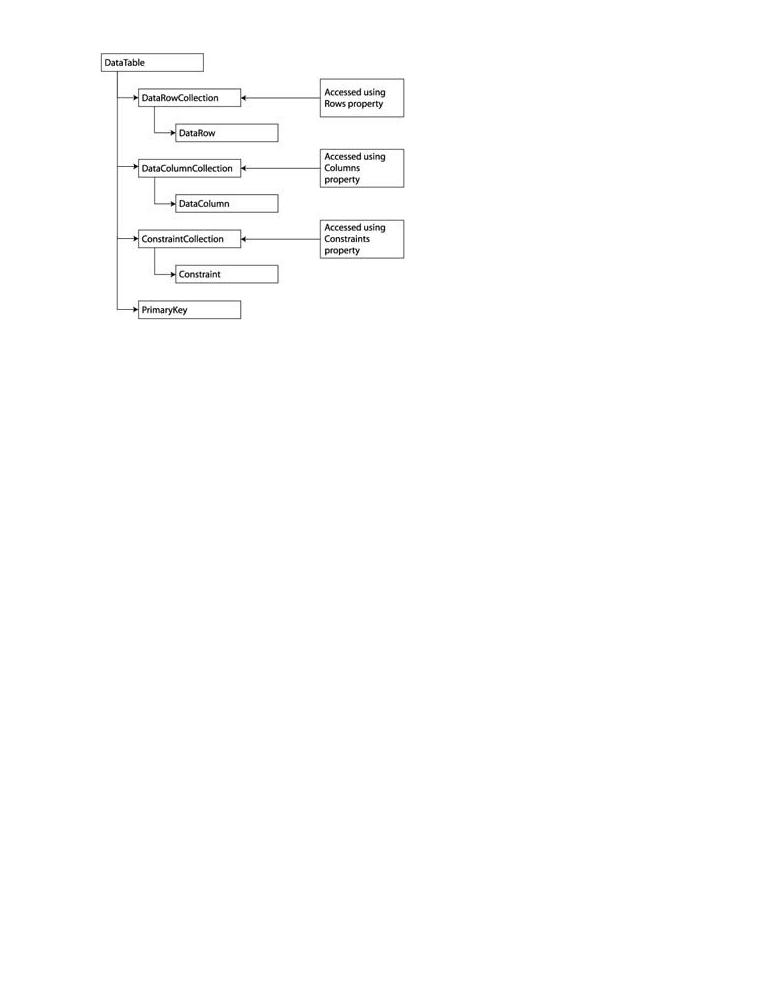
Edition
ISBN:1590590554
overview of the key technical and
Table
C# and
Part
Chapter
Chapter
Part
Chapter
ChapterFigure4 - 17Object-5: The-OrientedstructureP ogrammingof an ADOwith.NETC#DataTable
Chapter 5 - Exceptions and Object Lifetime
Chapter 6 - Interfaces and Collections
Chapter 7 - Callback Interfaces, Delegates, and Events
Chapter 8 - Advanced C# Type Construction Techniques
Part Three - Programming with .NET Assemblies
Chapter 9 - Understanding .NET Assemblies
Chapter 10 - Processes, AppDomains, Contexts, and Threads
Chapter 11 - Type Reflection, Late Binding, and Attribute-Based Programming
Part Four - Leveraging the .NET Libraries
Chapter 12 - Object Serialization and the .NET Remoting Layer Chapter 13 - Building a Better Window (Introducing Windows Forms) Chapter 14 - A Better Painting Framework (GDI+)
Chapter 15 - Programming with Windows Forms Controls
Chapter 16 - The System.IO Namespace
Chapter 17 - Data Access with ADO.NET
Part Five - Web Applications and XML Web Services
Chapter 18 - ASP.NET Web Pages and Web Controls
Chapter 19 - ASP.NET Web Applications
Chapter 20 - XML Web Services
Index
List of Figures
List of Tables
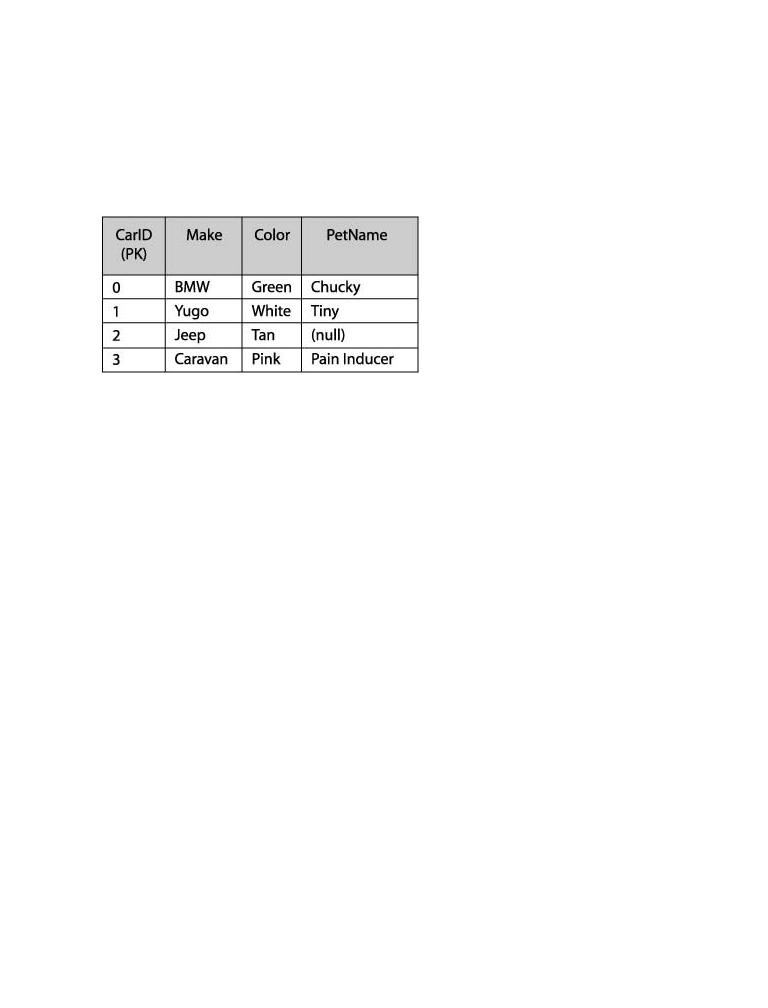
Building a Complete# and the .NETDataTablePlatform, S cond Edition
by Andrew Troelsen |
ISBN:1590590554 |
Now that you have been exposed to the basics, let's see a complete example of creating and manipulating
Apress © 2003 (1200 pages)
an in-memory data table. Assume you are interested in building a DataTable representing the current
This comprehensive text starts with a brief overview of the
inventory in a databaseC# languagenamedandCarsthen. ThequicklyInventorym vestableto keywilltecontainh ical andfour columns: CarID, Make, Color, and PetName. Also,architecturalthe CarIDissuescolumnfor will.NETfunctiondevelopersas the. table's primary key (PK) and support autoincrementation. The PetName column will allow null values. (Sadly, not everyone loves their automobiles as much as we might.) Figure 17-6 shows the overall schema.
Table of Contents
C# and the .NET Platform, Second Edition
Part
Chapter
Chapter
Part
Chapter
Chapter
Chapter
Chapter
Chapter 7 - Callback Interfaces, Delegates, and Events
Figure 17-6: The DataTable under construction
Chapter 8 - Advanced C# Type Construction Techniques
Part Three - Programming with .NET Assemblies
The process begins by creating a new DataTable type. When you do so, you specify the friendly name of
Chapter 9 - Understanding .NET Assemblies
the table as a constructor parameter (as shown next). This friendly name can be used to reference this
Chapter 10 - Processes, AppDomains, Contexts, and Threads
table from the containing DataSet:
Chapter 11 - Type Reflection, Late Binding, and Attribute-Based Programming
Part Four - Leveraging the .NET Libraries
// Create a new DataTable.
Chapter 12 - Object Serialization and the .NET Remoting Layer
DataTable inventoryTable = new DataTable("Inventory");
Chapter 13 - Building a Better Window (Introducing Windows Forms)
Chapter 14 - A Better Painting Framework (GDI+)
Chapter 15 - Programming with Windows Forms Controls
The next step is to programmatically insert each column using the Add() method of the
Chapter 16 - The System.IO Namespace
DataColumnCollection (accessed using the DataTable.Columns property). The following logic adds the
Chapter 17 - Data Access with ADO.NET
CarID, Make, Color, and PetName columns to the current DataTable (recall that the underlying data type
Part Five - Web Applications and XML Web Services
of each column is set using the DataType property):
Chapter 18 - ASP.NET Web Pages and Web Controls
Chapter 19 - ASP.NET Web Applications
// DataColumn var.
Chapter 20 - XML Web Services
DataColumn myDataColumn;
Index
// Create CarID column and add to table.
List of Figures
myDataColumn = new DataColumn();
List of Tables
myDataColumn.DataType = Type.GetType("System.Int32");
myDataColumn.ColumnName = "CarID";
myDataColumn.ReadOnly = true;
myDataColumn.AllowDBNull = false;
myDataColumn.Unique = true;
// Set the auto-increment behavior.
myDataColumn.AutoIncrement = true;
myDataColumn.AutoIncrementSeed = 1000;
myDataColumn.AutoIncrementStep = 10;
inventoryTable.Columns.Add(myDataColumn);
// Create Make column and add to table.
myDataColumn = new DataColumn();
myDataColumn.DataType = Type.GetType("System.String");
myDataColumn.ColumnName = "Make";
inventoryTable.Columns.Add(myDataColumn);
// Create Color column and add to table.

myDataColumn = new DataColumn();
C# and the .NET Platform, Second Edition myDataColumn.DataType = Type.GetType("System.String");
by Andrew Troelsen |
ISBN:1590590554 |
myDataColumn.ColumnName = "Color"; |
|
Apress © 2003 (1200 pages)
inventoryTable.Columns.Add(myDataColumn);
This comprehensive text starts withtablebrief overview of the
// Create PetName column and add to .
C# language and then quickly moves to key technical and myDataColumn = new DataColumn();
architectural issues for .NET developers. myDataColumn.DataType = Type.GetType("System.String");
myDataColumn.ColumnName = "PetName";
myDataColumn.AllowDBNull = true;
Table of Contents
inventoryTable.Columns.Add(myDataColumn);
C# and the .NET Platform, Second Edition
Introduction
Part One - Introducing C# and the .NET Platform
Before you add the rows, you will do well to take the time to set the table's primary key. To do so, set the
Chapter 1 - The Philosophy of .NET
DataTable.PrimaryKey property to whichever column necessary. Because more than a single column can
Chapter 2 - Building C# Applications
function as a table's primary key, be aware that the PrimaryKey property requires an array of DataColumn ParttypesTwo. For- ThetheC#InventoryProgrammingtable, assumeLanguagethe CarID column is the only aspect of the primary key, as shown
Chere:apter 3 - C# Language Fundamentals
Chapter 4 - Object-Oriented Programming with C#
Chapter 5 - Exceptions and Object Lifetime
// Make the ID column the primary key column.
Chapter 6 - Interfaces and Collections
DataColumn[] PK = new DataColumn[1];
Chapter 7 - Callback Interfaces, Delegates, and Events
PK[0] = inventoryTable.Columns["CarID"];
ChaptinventoryTabler 8 - Advanced.PrimaryKeyC# Type Construction= PK; Techniques
Part Three - Programming with .NET Assemblies
Chapter 9 - Understanding .NET Assemblies
Last but not least, you need to add valid data to the table. Assuming you have an appropriate ArrayList
Chapter 10 - Processes, AppDomains, Contexts, and Threads
maintaining Car types, you can fill the table as shown here:
Chapter 11 - Type Reflection, Late Binding, and Attribute-Based Programming
Part Four - Leveraging the .NET Libraries
// Iterate over the array list to fill rows (remember, the ID is
Chapter 12 - Object Serialization and the .NET Remoting Layer
// auto-incremented).
Chapter 13 - Building a Better Window (Introducing Windows Forms)
foreach(Car c in arTheCars)
Chapter 14 - A Better Painting Framework (GDI+)
{
Chapter 15 - Programming with Windows Forms Controls
DataRow newRow;
Chapter 16 - The System.IO Namespace
newRow = inventoryTable.NewRow();
Chapter 17 - Data Access with ADO.NET
newRow["Make"] = c.make;
Part Five - Web Applications and XML Web Services
newRow["Color"] = c.color;
Chapter 18 - ASP.NET Web Pages and Web Controls newRow["PetName"] = c.petName;
Chapter 19 - ASP.NET Web Applications inventoryTable.Rows.Add(newRow);
Chapter 20 - XML Web Services
}
Index
List of Figures
ListToofdisplayTablesyour new local in-memory table, assume you have a Windows Forms application with a main Form displaying a DataGrid. As you saw in Chapter 11, the DataSource property is used to bind a DataTable to the GUI. The output is shown in Figure 17-7.
Figure 17-7: The visual representation of the DataTable

Here, you added rows by specifying the string name of the column to modify. However, you may also
C# and the .NET Platform, Second Edition
specify the numerical index of the column, which can be very helpful when you need to iterate over each
by Andrew Troelsen ISBN:1590590554
column. Thus, the previous code could be updated as shown here (and still achieve the same end result):
Apress © 2003 (1200 pages)
This comprehensive text starts with a brief overview of the
foreach(Car c in arTheCars)
C# language and then quickly moves to key technical and
{architectural issues for .NET developers.
//Specify columns by index.
DataRow newRow;
Table of newRowContents= inventoryTable.NewRow();
newRow[1] = c.make;
C# and the .NET Platform, Second Edition
newRow[2] = c.color;
Introduction
newRow[3] = c.petName;
Part One - Introducing C# and the .NET Platform
inventoryTable.Rows.Add(newRow);
Chapter 1 - The Philosophy of .NET
}
Chapter 2 - Building C# Applications
Part Two - The C# Programming Language
Chapter 3 - C# Language Fundamentals
ChapterManipulating4 - Object-Orienteda DataTable:Progr mming withDeletingC# Rows
Chapter 5 - Exceptions and Object Lifetime
What if you wish to remove a row from a data table? One approach is to call the Delete() method of the
Chapter 6 - Interfaces and Collections
DataRowCollection type. Simply specify the index (or DataRow) representing the row to remove. Assume
Chapter 7 - Callback Interfaces, Delegates, and Events
you update your GUI as shown in Figure 17-8. |
|
Chapter 8 - Advanced C# Type Construction Techniques |
|
Part Three - Programming with .NET Assemblies |
|
Chapter |
|
Chapter |
Threads |
Chapter |
-Based Programming |
Part |
|
Chapter |
Layer |
Chapter |
Windows Forms) |
Chapter |
|
Chapter |
|
Chapter
ChapterFigure17 - 17Data-8:AccessRemovingwith rowsADO.NETfrom the DataTable
Part Five - Web Applications and XML Web Services
If you look at the previous screen shot, you will notice that you specified the second row in the DataTable,
Chapter 18 - ASP.NET Web Pages and Web Controls
and therefore CarID 1020 has been marked as deleted. The following logic behind the new Button's Click
Chapter 19 - ASP.NET Web Applications
event handler removes the specified row from your in-memory DataTable:
Chapter 20 - XML Web Services
Index
// Remove this row from the DataRowCollection.
List of Figures
protected void btnRemoveRow_Click (object sender, System.EventArgs e)
List of Tables
{
try
{
inventoryTable.Rows[(int.Parse(txtRemove.Text))].Delete(); inventoryTable.AcceptChanges();
}
catch(Exception ex)
{
MessageBox.Show(ex.Message);
}
}
The Delete() method might have been better named MarkedAsDeletable() given that the row is not literally removed until the DataTable.AcceptChanges() method has been called. In effect, the Delete() method
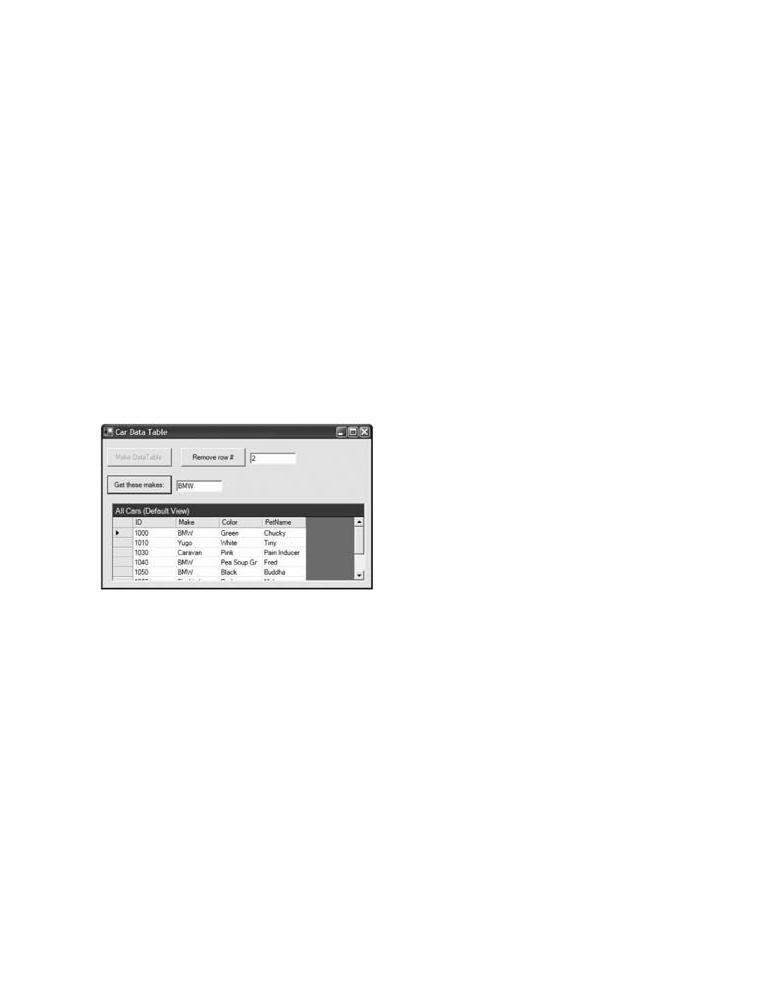
simply sets a flag that says "I am ready to die when my table tells me." Also understand that if a row has
C# and the .NET Platform, Second Edition
been marked for deletion, a DataTable may reject the delete operation via RejectChanges(), as shown
here: |
by Andrew Troelsen |
ISBN:1590590554 |
Apress © 2003 (1200 pages) |
|
|
|
|
This comprehensive text starts with a brief overview of the
// Mark a row as deleted, but reject the changes.
C# language and then quickly moves to key technical and
protected void btnRemoveRow_Click (object sender, System.EventArgs e) architectural issues for .NET developers.
{
inventoryTable.Rows[(int.Parse(txtRemove.Text))].Delete();
Table of //ContentsDo more work
C# and the...NET Platform, Second Edition
inventoryTable.RejectChanges(); // Restore previous RowState value.
Introduction
}
Part One - Introducing C# and the .NET Platform
Chapter 1 - The Philosophy of .NET
Chapter 2 - Building C# Applications
PartManipulatingTwo - The C# Programminga DataTable:Language Applying Filters and Sort Orders
Chapter 3 - C# Language Fundamentals
You may wish to see a small subset of a DataTable's data, as specified by some sort of filtering criteria.
Chapter 4 - Object-Oriented Programming with C#
For example, what if you wish to only see a certain make of automobile from the in-memory Inventory
Chapter 5 - Exceptions and Object Lifetime
table? The Select() method of the DataTable class provides this very functionality. Update your GUI once
Chapter 6 - Interfaces and Collections
again, this time allowing users to specify a string that represents the make of the automobile they are
Chapter 7 - Callback Interfaces, Delegates, and Events
interested in viewing (Figure 17-9). The result will be placed into a Windows Forms message box. |
|
Chapter 8 - Advanced C# Type Construction Techniques |
|
Part Three - Programming with .NET Assemblies |
|
Chapter |
|
Chapter |
Threads |
Chapter |
-Based Programming |
Part |
|
Chapter |
Layer |
Chapter |
Windows Forms) |
Chapter |
|
Chapter |
|
Chapter |
|
Chapter
Part FiveFigure- Web17-Applications9: SpecifyingandfilterXML Web Services
Chapter 18 - ASP.NET Web Pages and Web Controls
The Select() method has been overloaded a number of times to provide different selection semantics. At
Chapter 19 - ASP.NET Web Applications
its most basic level, the parameter sent to Select() is a string that contains some conditional operation. To
Chapter 20 - XML Web Services
begin, observe the following logic for the Click event handler of your new Button:
Index
List of Figures
protected void btnGetMakes_Click (object sender, System.EventArgs e)
List of Tables
{
// Build a filter based on user input.
string filterStr = "Make='" + txtMake.Text + "'";
// Find all rows matching the filter.
DataRow[] makes = inventoryTable.Select(filterStr);
// Show what we got!
if(makes.Length == 0)
MessageBox.Show("Sorry, no cars...", "Selection error!");
else
{
string strMake = null;
for(int i = 0; i < makes.Length; i++)
{
DataRow temp = makes[i];
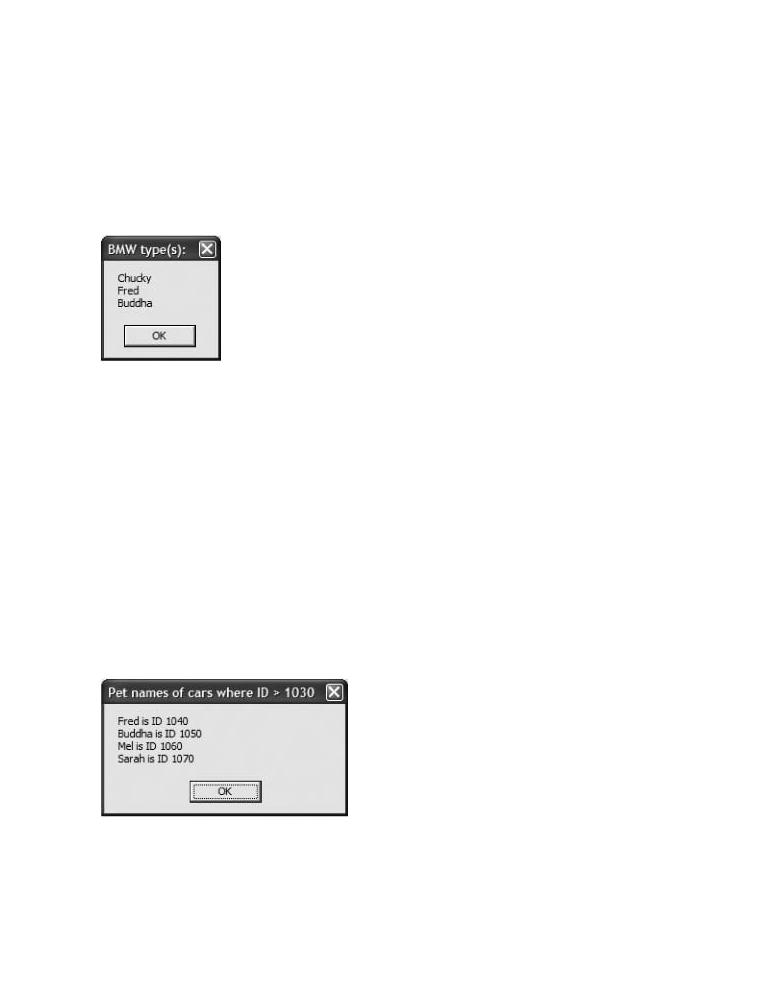
strMake += temp["PetName"] + "\n";
} |
C# and the .NET Platform, Second Edition |
|
by Andrew Troelsen |
ISBN:1590590554 |
MessageBox.Show(strMake, txtMake.Text + " type(s):");
}Apress © 2003 (1200 pages)
}This comprehensive text starts with a brief overview of the C# language and then quickly moves to key technical and architectural issues for .NET developers.
Here, you first build a simple filter criteria based on the value in the associated TextBox. If you specify
BMW, your filter is Make = 'BMW'. When you send this filter to the Select() method, you get back an array
Table of Contents
of DataRow types that represent each row that matches the filter criteria (Figure 17-10).
C# and the .NET Platform, Second Edition
Introduction
Part |
and the .NET Platform |
Chapter |
of .NET |
Chapter |
Applications |
Part |
Language |
Chapter |
Fundamentals |
Chapter |
Programming with C# |
Chapter |
Object Lifetime |
Chapter 6 - Interfaces and Collections
Figure 17-10: Filtered data
Chapter 7 - Callback Interfaces, Delegates, and Events
Chapter 8 - Advanced C# Type Construction Techniques
A filter string can be composed of any number of relational operators. For example, what if you wanted to
Part Three - Programming with .NET Assemblies
find all cars with an ID greater than 1030? You could write the following (see Figure 17-11 for output):
Chapter 9 - Understanding .NET Assemblies
Chapter 10 - Processes, AppDomains, Contexts, and Threads
// Now show the pet names of all cars with ID greater than 1030.
Chapter 11 - Type Reflection, Late Binding, and Attribute-Based Programming
DataRow[] properIDs;
Part Four - Leveraging the .NET Libraries
stringnewFilterStr = "ID > '1030'";
Chapter 12 - Object Serialization and the .NET Remoting Layer properIDs = inventoryTable.Select(newFilterStr);
Chapter 13 - Building a Better Window (Introducing Windows Forms) string strIDs = null;
Chapter 14 - A Better Painting Framework (GDI+) for(int i = 0; < properIDs.Length; i++)
Chapter{ 15 - Programming with Windows Forms Controls
Chapter DataRow16 - The Systemtemp.IO= NamespaceproperIDs[i];
Chapter strIDs17 - Data+=Accesstemp["PetName"]with ADO.NET
Part Five - Web Applicat+ " isonsIDand"XML+ Wtemp["ID"]b Services + "\n";
}
Chapter 18 - ASP.NET Web Pages and Web Controls
MessageBox.Show(strIDs, "Pet names of cars where ID > 1030");
Chapter 19 - ASP.NET Web Applications
Chapter 20 - XML Web Services
Index
List of
List of
Figure 17-11: Specifying a range of data
As you can see, filtering logic is standard SQL syntax. To prove the point, assume you wish to obtain the results of the previous Select() invocation alphabetically based on pet name. In terms of SQL, this translates into a sort based on the PetName column. Luckily, the Select() method has been overloaded to send in a sort criterion, as shown here:
makes = inventoryTable.Select(filterStr, "PetName");

C# and the .NET Platform, Second Edition
If you want the results in descending order, call Select(), as shown here:
by Andrew Troelsen |
ISBN:1590590554 |
Apress © 2003 (1200 pages)
// Return results in descending order.
This comprehensive text starts with a brief overview of the
makes = inventoryTable.Select(filterStr, "PetName DESC");
C# language and then quickly moves to key technical and
architectural issues for .NET developers.
In general, the sort string contains the column name followed by "ASC" (ascending, which is the default)
or "DESC" (descending). If need be, multiple columns can be separated by commas.
Table of Contents
C# and the .NET Platform, Second Edition
IntroductionManipulating a DataTable: Updating Rows
Part One - Introducing C# and the .NET Platform
ChapterThe final1 aspect- The Philosophyof the DataTableof .NET you should be aware of is the process of updating an existing row with
new values. One approach is to first obtain the row(s) that match a given filter criterion using the Select()
Chapter 2 - Building C# Applications
method. Once you have the DataRow(s) in question, modify them accordingly. For example, assume you
Part Two - The C# Programming Language
have a new Button that (when clicked) searches the DataTable for all rows where Make is equal to BMW.
Chapter 3 - C# Language Fundamentals
Once you identify these items, you change the Make from "BMW" to "Colt":
Chapter 4 - Object-Oriented Programming with C#
Chapter 5 - Exceptions and Object Lifetime
// Find the rows you want to edit with a filter.
Chapter 6 - Interfaces and Collections
protected void btnChange_Click (object sender, System.EventArgs e)
Chapter 7 - Callback Interfaces, Delegates, and Events
{
Chapter 8 - Advanced C# Type Construction Techniques
// Build a filter.
Part Three - Programming with .NET Assemblies
string filterStr = "Make='BMW'";
Chapter 9 - Understanding .NET Assemblies
string strMake = null;
Chapter 10 - Processes, AppDomains, Contexts, and Threads
// Find all rows matching the filter.
Chapter 11 - Type Reflection, Late Binding, and Attribute-Based Programming
DataRow[] makes = inventoryTable. Select(filterStr);
Part Four - Leveraging the .NET Libraries
// Change all Beemers to Colts!
Chapter 12 - Object Serialization and the .NET Remoting Layer for(int i = 0; i < makes.Length; i++)
Chapter 13 - Building a Better Window (Introducing Windows Forms)
{
Chapter 14 - A Better Painting Framework (GDI+)
DataRow temp = makes[i];
Chapter 15 - Programming with Windows Forms Controls strMake += temp["Make"] = "Colt";
Chapter 16 - The System.IO Namespace makes[i] = temp;
Chapter 17 - Data Access with ADO.NET
}
Part Five - Web Applications and XML Web Services
}
Chapter 18 - ASP.NET Web Pages and Web Controls
Chapter 19 - ASP.NET Web Applications
The DataRow class also provides the BeginEdit(), EndEdit(), and CancelEdit() methods, which allow you
Chapter 20 - XML Web Services
to edit the content of a row while temporarily suspending any associated validation rules. In the previous
Index
logic, each row was validated with each assignment. (Also, if you capture any events from the DataRow,
List of Figures
they fire with each modification.) When you call BeginEdit() on a given DataRow, the row is placed in edit
List of Tables
mode. At this point you can make your changes as necessary and call either EndEdit() to commit these changes or CancelEdit() to roll back the changes to the original version. For example:
//Assume you have obtained a row to edit.
//Now place this row in edit mode.
rowToUpdate.BeginEdit();
// Send the row to a helper function, which returns a Boolean.
if( ChangeValuesForThisRow(rowToUpdate) )
{
rowToUpdate.EndEdit(); |
// OK! |
}
else
{
rowToUpdate.CancelEdit(); |
// Forget it. |
}

C# and the .NET Platform, Second Edition |
|
Although you are free to manually call these methods on a given DataRow, these members are |
|
by Andrew Troelsen |
ISBN:1590590554 |
automatically called when you edit a DataGrid widget that has been bound to a DataTable. For example,
Apress © 2003 (1200 pages)
when you select a row to edit from a DataGrid, that row is automatically placed in edit mode. When you
This comprehensive text starts with a brief overview of the
shift focus to a new row, EndEdit() is called automatically. To test this behavior, assume you have
C# language and then quickly moves to key technical and
manually updated each car to be of a given Make using the DataGrid (Figure 17-12). architectural issues for .NET developers.
Table
C# and
Part
Chapter
Chapter
Part
Chapter
Chapter
Chapter
Figure 17-12: Editing rows in a DataGrid
Chapter 6 - Interfaces and Collections
Chapter 7 - Callback Interfaces, Delegates, and Events
Chapter 8 - Advanced C# Type Construction Techniques
If you now request all BMWs, the message box correctly returns all rows, as the underlying DataTable
Part Three - Programming with .NET Assemblies |
|
associated to the DataGrid has been automatically updated (Figure 17-13). |
|
Chapter 9 - Understanding .NET Assemblies |
|
Chapter 10 - Processes, AppDomains, Contexts, and Threads |
|
Chapter |
Late Binding, and Attribute-Based Programming |
Part |
.NET Libraries |
Chapter |
and the .NET Remoting Layer |
Chapter |
Window (Introducing Windows Forms) |
Chapter |
Framework (GDI+) |
Chapter |
with Windows Forms Controls |
Chapter |
Namespace |
Chapter |
with ADO.NET |
Part |
and XML Web Services |
Figure 17-13: The updated set of BMW autos
Chapter 18 - ASP.NET Web Pages and Web Controls
Chapter 19 - ASP.NET Web Applications
Chapter 20 - XML Web Services
Index
List of Figures
List of Tables

UnderstandingC# andthet .DataViewNET Platform, TypeSecond Edition
by Andrew Troelsen |
ISBN:1590590554 |
In database nomenclature, a view object is a stylized representation of a table. For example, using
Apress © 2003 (1200 pages)
Microsoft SQL Server, you could create a view for your current Inventory table that returns a new table only
This comprehensive text starts with a brief overview of the
containing automobilesC# languageof a givenand thencolorquickly. In ADOmoves.NET,tothekeyDataViewtechnical typeand allows you to programmatically extract a subset ofarchitecturaldata from theissuesDataTablefor .NET.developers.
One great advantage of holding multiple views of the same table is that you can bind these views to
Tablevariousof ContentsGUI widgets (such as the DataGrid). For example, one DataGrid might be bound to a DataView C#showingand theall.NETautosPlatform,in the Inventory,Second Editionwhile another may be configured to display only green automobiles. On
a related note, the DataTable type provides the DefaultView property that returns the default DataView for
Introduction
the table.
Part One - Introducing C# and the .NET Platform
Chapter 1 - The Philosophy of .NET
To illustrate, update the user interface of the current Windows Forms application to support two additional DataGrid types. One of these grids only shows the rows from the Inventory that match the filter
Make='Colt'. The other grid only shows red automobiles (i.e., Color='Red'). Figure 17-14 shows the GUI
Chapter 3 - C# Language Fundamentals update.
Chapter 4 - Object-Oriented Programming with C# Chapter 5 - Exceptions and Object Lifetime Chapter
Chapter
Chapter
Part |
|
Chapter |
|
Chapter |
Threads |
Chapter |
-Based Programming |
Part |
|
Chapter |
Layer |
Chapter |
Windows Forms) |
Chapter |
|
Chapter |
|
Chapter |
|
Chapter |
|
Part |
|
Chapter
Chapter
Chapter 20 - XML Web Services
Figure 17-14: Creating multiple views for a single DataTable
Index
List of Figures
To begin, you need to create two member variables of type DataView:
List of Tables
public class mainForm : System.Windows.Forms.Form
{
// Views |
of the DataTable. |
// |
I |
only |
show |
red cars. |
DataView |
redCarsView; |
|||||
DataView |
coltsView; |
// |
I |
only |
show |
Colts. |
...
}
Next, assume you have a new helper function named CreateViews(), which is called directly after the DataTable has been fully constructed, as shown here:
protected void btnMakeDataTable_Click (object sender, System.EventArgs e)
{

// Make the data table.
C# and the .NET Platform, Second Edition
MakeTable();
|
|
by Andrew Troelsen |
ISBN:1590590554 |
|
|
// Make views. |
|
||
|
|
Apress © 2003 (1200 pages) |
|
|
|
CreateViews(); |
|
||
|
... |
This comprehensive text starts with a brief overview of the |
||
} |
C# language and then quickly moves to key technical and |
|||
|
||||
|
architectural issues for .NET developers. |
|
||
Table of Contents
Here is the implementation of this new helper function. Notice that the constructor of each DataView has
C# and the .NET Platform, Second Edition
been passed the DataTable that will be used to build the custom set of data rows:
Introduction
Part One - Introducing C# and the .NET Platform
private void CreateViews()
Chapter 1 - The Philosophy of .NET
{
Chapter 2 - Building C# Applications
// Set the table that is used to construct these views.
Part Two - The C# Programming Language
redCarsView = new DataView(inventoryTable);
Chapter 3 - C# Language Fundamentals
coltsView = new DataView(inventoryTable);
Chapter 4 - Object-Oriented Programming with C#
// Now configure the views using a filter.
Chapter 5 - Exceptions and Object Lifetime redCarsView.RowFilter = "Color = 'red'";
Chapter 6 - Interfaces and Collections
coltsView.RowFilter = "Make = 'colt'";
Chapter 7 - Callback Interfaces, Delegates, and Events
// Bind to grids.
Chapter RedCarViewGrid8 - Advanced C# Type.DataSourceConstruction=TechniquesredCarsView;
Part ThreeColtsViewGrid- Programming with.DataSource.NET Assemblies= coltsView;
Chapter} 9 - Understanding .NET Assemblies
Chapter 10 - Processes, AppDomains, Contexts, and Threads
Chapter 11 - Type Reflection, Late Binding, and Attribute-Based Programming
As you can see, the DataView class supports a property named RowFilter, which contains the string
Part Four - Leveraging the .NET Libraries
representing the filtering criteria used to extract matching rows. Once you have your view established, set
Chapter 12 - Object Serialization and the .NET Remoting Layer
the grid's DataSource property accordingly. That's it! Because DataGrids are smart enough to detect
Chapter 13 - Building a Better Window (Introducing Windows Forms)
changes to their underlying data source, if you click the Make Beemers Colts button, the ColtsViewGrid is
Chapter 14 - A Better Painting Framework (GDI+) updated automatically.
Chapter 15 - Programming with Windows Forms Controls
ChapterIn addition16 -toThetheSystemRowFilter.IO Namespaceproperty, Table 17-8 describes some other members of the DataView class.
Chapter 17 - Data Access with ADO.NET
|
Table 17-8: Members of the DataView Type |
||||||
Part Five - Web Applicati ns and XML Web Services |
|||||||
|
|
|
|
|
|
|
|
|
|
Chapter 18 - ASP.NET Web |
|
Pages and Web Controls |
|
||
|
|
ChapterDataView19 - ASP.NET Web |
|
MeaningApplicationsin Life |
|
|
|
|
|
ChapterMember20 - XML Web Services |
|
|
|||
|
|
|
|||||
|
|
|
|
|
|
|
|
|
Index |
|
|
Adds a new row to the DataView |
|
|
|
|
|
AddNew() |
|
|
|
|
|
|
|
|
|
|
|
|
|
List of Figures |
|
|
Configure whether the DataView allows deleting, inserting, or updating of |
|
|
||
|
|
AllowDelete |
|
|
|
|
|
List of Tables |
|
|
its rows |
|
|
||
|
|
AllowEdit |
|
|
|
|
|
|
|
|
|
|
|
|
|
|
|
AllowNew |
|
|
|
|
|
|
|
|
|
|
|
|
|
|
|
Delete() |
|
|
Deletes a row at the specified index |
|
|
|
|
|
|
|
|
|
|
|
|
RowFilter |
|
|
Gets or sets the expression used to filter which rows are viewed in the |
|
|
|
|
|
|
|
DataView |
|
|
|
|
|
|
|
|
|
|
|
|
Sort |
|
|
Gets or sets the sort column or columns and sort order for the table |
|
|
|
|
|
|
|
|
|
|
|
|
Table |
|
|
Gets or sets the source DataTable |
|
|
|
|
|
|
|
|
|
|
|
|
SOURCE |
The CarDataTable project is included under the Chapter 17 subdirectory. |
||||
|
|
CODE |
|
|
|
|
|
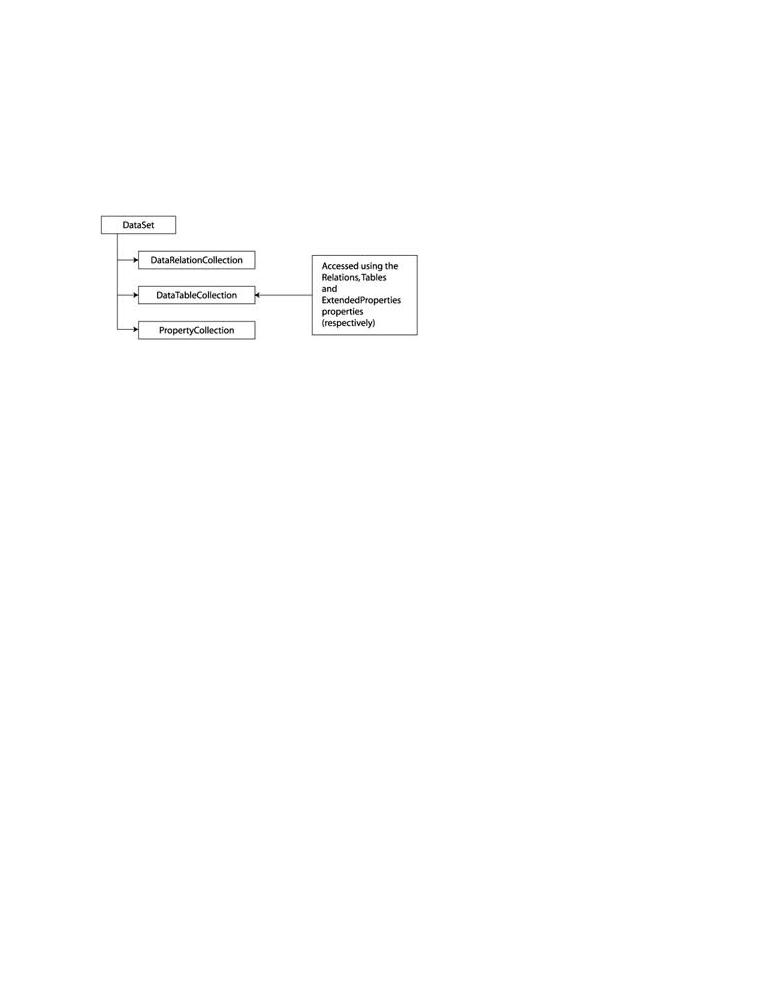
UnderstandingC# andthet .RoleNET Platform,of theSecondDataSetEdition
by Andrew Troelsen |
ISBN:1590590554 |
You have been examining how to build a DataTable to represent a single table of data held in memory.
Apress © 2003 (1200 pages)
Although DataTables can be used as stand-alone entities, they are more typically contained in a DataSet.
This comprehensive text starts with a brief overview of the
Simply put, a DataSetC# languageis an in-andmemorythen quicklyrepresentationmoves toofkeyanytechnicalnumberandof tables (which may be just a single DataTable) as wellarchitecturalas any (optional)issues forrelationships.NET developbetweenrs. these tables and any (optional) constraints. To gain a better understanding of the relationship among these core types, consider the logical hierarchy shown in Figure 17-15.
Table of Contents
C# and the .NET Platform, Second Edition
Part
Chapter
Chapter
Part
Chapter
Chapter
Chapter 5 - Exceptions and Object Lifetime
Figure 17-15: The anatomy of a DataSet
Chapter 6 - Interfaces and Collections
ChapterThe Tables7 - CallbackpropertyInterfaces,of the DataSetDelegates,allowsandyouEventsto access the DataTableCollection that contains the
individual DataTables. Another important collection used by the DataSet is the DataRelationCollection.
Chapter 8 - Advanced C# Type Construction Techniques
Given that a DataSet is a disconnected version of a database schema, it can programmatically represent
Part Three - Programming with .NET Assemblies
the parent/child relationships between its tables.
Chapter 9 - Understanding .NET Assemblies
Chapter 10 - Processes, AppDomains, Contexts, and Threads
For example, a relation can be created between two tables to model a foreign key constraint using the
Chapter 11 - Type Reflection, Late Binding, and Attribute-Based Programming
DataRelation type. This object can then be added to the DataRelationCollection through the Relations
Part Four - Leveraging the .NET Libraries
property. At this point, you can navigate between the connected tables as you search for data. You will see
Chapter 12 - Object Serialization and the .NET Remoting Layer how this is done a bit later in the chapter.
Chapter 13 - Building a Better Window (Introducing Windows Forms) ChapterThe ExtendedProperties14 - A Better PaintingpropertyFramewprovidesrk (GDI+)access to the PropertyCollection type, which allows you to Chapterassociate15 any- Programmingextra informationwi h Windowsto the DataSetForms Controlsas name/value pairs. This information can literally be
anything at all, even if it has no bearing on the data itself. For example, you can associate your company's
Chapter 16 - The System.IO Namespace
name to a DataSet, which can then function as in-memory metadata, as shown here:
Chapter 17 - Data Access with ADO.NET
Part Five - Web Applications and XML Web Services
Chapter// Make18 -aASPDataSet.NET WebandPagesaddand someWeb Controlsmetadata.
ChDataSetpter 19 -dsASP=.NETnewWebDataSet("MyDataSet");Applica ions
ds.ExtendedProperties.Add("CompanyName", "Intertech, Inc");
Chapter 20 - XML Web Serv ces
// Print out the metadata.
Index
Console.WriteLine(ds.ExtendedProperties["CompanyName"].ToString());
List of Figures
List of Tables
Other examples of extended properties might include an internal password that must be supplied to access the contents of the DataSet, a number representing a data refresh rate, and so forth. Be aware that the DataTable itself also supports the ExtendedProperties property.
Members of the DataSet
Before exploring too many other programmatic details, take a look at the public interface of the DataSet. The properties defined by the DataSet are centered on providing access to the internal collections, producing XML data representations and providing detailed error information. Table 17-9 describes some core properties of interest.
Table 17-9: Properties of the Mighty DataSet

|
|
|
|
|
|
|
|
|
|
|
|
|
DataSet |
C# and |
theMeaning.NET Platform,in LifeS cond Edition |
|
|
||
|
|
|
Property |
by Andrew |
|
Troelsen |
ISBN:1590590554 |
|
|
|
|
|
|
|
|
|
|
|
|
|
|
|
CaseSensitive |
Apress © |
2003 (1200 pages) |
|
|
||
|
|
|
|
|
Indicates whether string comparisons in DataTable objects are case |
|
|||
|
|
|
|
|
This comprehensive text starts with a brief overview of the |
|
|||
|
|
|
|
|
|
|
sensitive (or not). |
|
|
|
|
|
|
|
C# language and then quickly moves to key technical and |
|
|||
|
|
|
|
|
|
|
|
|
|
|
|
|
DataSetName |
architectural |
issues for .NET developers. |
|
|
||
|
|
|
|
|
Represents the friendly name of this DataSet. Typically this value is |
|
|||
|
|
|
|
|
|
|
established as a constructor parameter. |
|
|
|
|
|
|
|
|
||||
|
|
|
DefaultViewManager |
|
Establishes a custom view of the data in the DataSet. |
|
|||
Table of Contents |
|
|
|
|
|
||||
|
|
|
|
|
|
||||
C# and the .NET Platform, |
|
Second Edition |
|
|
|||||
|
|
|
EnforceConstraints |
|
Gets or sets a value indicating whether constraint rules are followed |
|
|||
Introduction |
|
|
when attempting any update operation. |
|
|||||
|
|
|
|
|
|
|
|
||
Part One - Introducing C# and the .NET Platform |
|
|
|||||||
|
|
||||||||
ChapterHasErrors1 - The Philosophy ofGets.NETa value indicating whether there are errors in any of the rows in any |
|
||||||||
Chapter 2 - Building C# Applicationsof the tables of this DataSet. |
|
|
|||||||
|
|
|
|
|
|
||||
Part Two - The C# Programming Language |
|
|
|||||||
|
|
|
Relations |
|
|
Gets the collection of relations that link tables and allows navigation |
|
||
Chapter 3 |
- C# Language Fundamentals |
|
|
||||||
|
|
|
|
|
|
|
from parent tables to child tables. |
|
|
|
Chapter 4 - Object-Oriented |
|
Programming with C# |
|
|
||||
|
|
|
|
|
|
||||
|
ChapterTables5 |
- Exceptions and |
|
ObjectProvidesLifetimeaccess to the collection of tables maintained by the DataSet. |
|
||||
|
|
|
|
|
|
|
|
|
|
Chapter 6 |
- Interfaces and Collections |
|
|
||||||
The methods of the DataSet mimic some of the functionality provided by the aforementioned properties. In
Chapter 7 - Callback Interfaces, Delegates, and Events
addition to interacting with XML streams, other methods exist to allow you to copy the contents of your
Chapter 8 - Advanced C# Type Construction Techniques
|
DataSet, as well as establish the beginning and ending points of a batch of updates. Table 17-10 |
||||||
Part Three - Programming with .NET Assemblies |
|||||||
|
describes some core methods. |
||||||
Chapter 9 |
- Understanding .NET Assemblies |
||||||
Chapter 10 |
- Processes, AppDomains, Contexts, and Threads |
||||||
|
Table 17-10: Methods of the Mighty DataSet |
||||||
|
|
Chapter 11 |
- Type Reflection, |
|
Late Binding, and Attribute-Based Programming |
|
|
|
|
|
|
|
|||
Part Four - Leveraging the |
|
.NET Libraries |
|
|
|||
|
|
DataSet Method |
|
Meaning in Life |
|
|
|
|
Chapter 12 |
- Object Serialization and the .NET Remoting Layer |
|
|
|||
|
|
|
|||||
|
|
AcceptChanges() |
|
Commits all the changes made to this DataSet since it was loaded or the |
|
|
|
|
Chapter 13 |
- Building a Better Window (Introducing Windows Forms) |
|
|
|||
|
|
|
|
|
last time AcceptChanges() was called. |
|
|
|
Chapter 14 |
- A Better Painting Framework (GDI+) |
|
|
|||
|
|
|
|||||
|
|
Chapter 15 |
- Programming |
|
with Windows Forms Controls |
|
|
|
|
Clear() |
|
|
Completely clears the DataSet data by removing every row in each |
|
|
|
Chapter 16 |
- The System.IO |
|
Namespace |
|
|
|
|
|
|
|
|
table. |
|
|
|
|
|
|
|
|
||
|
|
Chapter 17 |
- Data Access with ADO.NET |
|
|
||
|
|
Clone() |
|
|
Clones the structure of the DataSet, including all DataTables, as well as |
|
|
Part Five - Web Applications and XML Web Services |
|
|
|||||
|
|
|
|
|
all relations and any constraints. |
|
|
|
Chapter 18 |
- ASP.NET Web |
|
Pages and Web Controls |
|
|
|
|
Chapter 19 |
- ASP.NET Web |
|
Applications |
|
|
|
|
|
Copy() |
|
|
Copies both the structure and data for this DataSet. |
|
|
|
|
|
|
|
|
||
|
|
Chapter 20 |
- XML Web Services |
|
|
||
|
|
GetChanges() |
|
Returns a copy of the DataSet containing all changes made to it since it |
|
|
|
Index |
|
|
was last loaded, or since AcceptChanges() was called. |
|
|
||
List of Figures |
|
|
|
||||
|
|
|
|
||||
|
|
|
|
||||
ListGetChildRelations()of Tables |
|
Returns the collection of child relations that belong to a specified table. |
|
|
|||
|
|
|
|
|
|
|
|
|
|
GetParentRelations() |
|
Gets the collection of parent relations that belong to a specified table. |
|
|
|
|
|
|
|
|
|
|
|
|
|
HasChanges() |
|
Overloaded. Gets a value indicating whether the DataSet has changes, |
|
|
|
|
|
|
|
|
including new, deleted, or modified rows. |
|
|
|
|
|
|
|
|
|
|
|
|
Merge() |
|
|
Overloaded. Merges this DataSet with a specified DataSet. |
|
|
|
|
|
|
|
|
|
|
|
|
ReadXml() |
|
These methods allow you to read XML data from a valid stream (file- |
|
|
|
|
|
ReadXmlSchema() |
|
based, memory-based, or network-based) into the DataSet. |
|
|
|
|
|
|
|
|
|
|
|
|
|
RejectChanges() |
|
Rolls back all the changes made to this DataSet since it was created, or |
|
|
|
|
|
|
|
|
the last time DataSet.AcceptChanges was called. |
|
|
|
|
|
|
|
|
|
|
|
|
WriteXml() |
|
These methods allow you to write out the contents of a DataSet into a |
|
|
|
|
|
WriteXmlSchema() |
|
valid stream. |
|
|
|
|
|
|
|
|
|
|
|
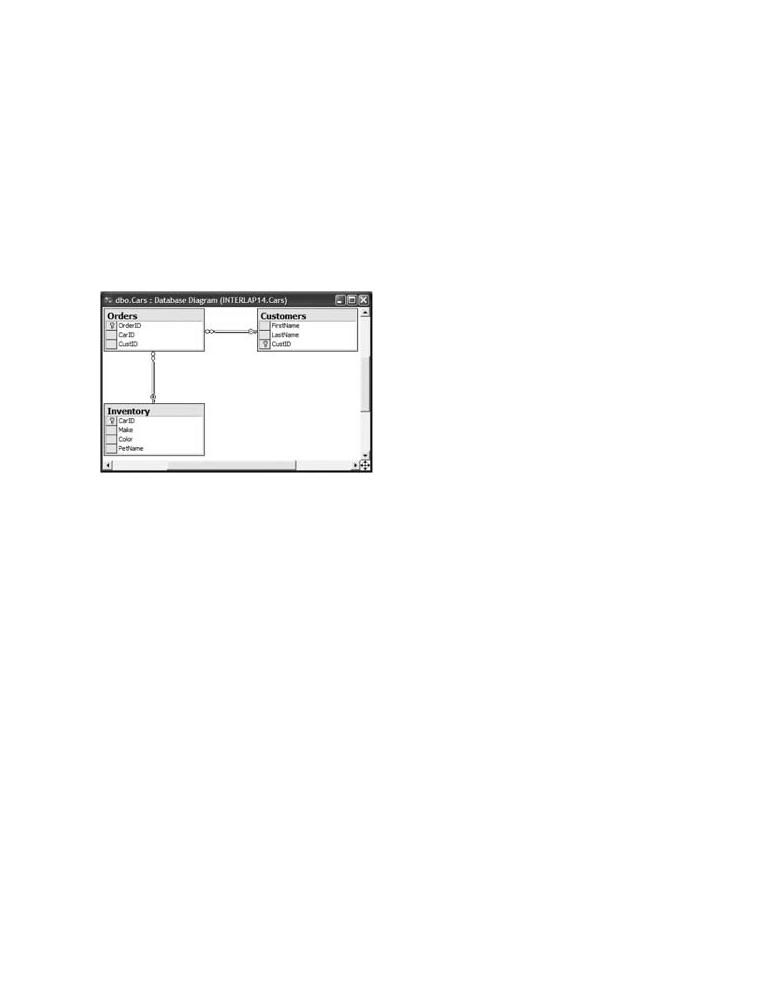
Now that you have a better understanding of the role of the DataSet (and some idea what you can do with
C# and the .NET Platform, Second Edition |
|
one), let's run through some specifics. Once this discussion of the ADO.NET DataSet is complete, the |
|
by Andrew Troelsen |
ISBN:1590590554 |
remaining bulk of this chapter will focus on how to obtain DataSet types from external sources (such as a
Apress © 2003 (1200 pages)
relational database) using the types defined by the System.Data.SqlClient and System.Data.OleDb
namespaces. This comprehensive text starts with a brief overview of the C# language and then quickly moves to key technical and
architectural issues for .NET developers.
Building an In-Memory DataSet
TableTo illustrateof Contentsthe use of a DataSet, create a new Windows Forms application that maintains a single C#DataSet,and thecontaining.NET Platform,threeSecondDataTableEditionobjects named Inventory, Customers, and Orders. The columns for
each table will be minimal but complete, with one column marking the primary key for each table. Most
Introduction
importantly, you can model the parent/child relationships between the tables using the DataRelation type.
Part One - Introducing C# and the .NET Platform
Your goal is to build the database shown in Figure 17-16 in memory.
Chapter 1 - The Philosophy of .NET
Chapter 2 - Building C# Applications
Part
Chapter
Chapter
Chapter
Chapter
Chapter
Chapter
Part
Chapter |
|
Chapter |
Threads |
Chapter |
-Based Programming |
Part FourFigure- Leveraging17-16: ThetheCars.NETdatabaseLibraries
Chapter 12 - Object Serialization and the .NET Remoting Layer
Here, the Inventory table is the parent table to the Orders table, which maintains a foreign key (CarID)
Chapter 13 - Building Better Window (Introducing Windows Forms)
column. Also, the Customers table is the parent table to the Orders table. (Again note the foreign key,
Chapter 14 - A Better Painting Framework (GDI+)
CustID.) As you will soon see, when you add DataRelation types to your DataSet, they may be used to
Chapter 15 - Programming with Windows Forms Controls
navigate between the tables to obtain and manipulate the related data.
Chapter 16 - The System.IO Namespace
Chapter 17 - Data Access with ADO.NET
To begin, assume you have added a set of member variables to your main Form, representing the
Part Five - Web Applications and XML Web Services
individual DataTables and containing DataSet, as shown here:
Chapter 18 - ASP.NET Web Pages and Web Controls
Chapter 19 - ASP.NET Web Applications
public class mainForm : System.Windows.Forms.Form
Chapter 20 - XML Web Services
{
Index // Inventory DataTable.
List of Figures
private DataTable inventoryTable = new DataTable("Inventory");
List of Tables
// Customers DataTable.
private DataTable customersTable = new DataTable("Customers");
// Orders DataTable.
private DataTable ordersTable = new DataTable("Orders");
// Our DataSet!
private DataSet carsDataSet = new DataSet("CarDataSet");
...
}
Now, to keep things as OO as possible, build some (very) simple wrapper classes to represent a Car and Customer in the system. Note that the Customer class maintains a field that identifies the car a customer is interested in buying, as shown here:
public class Car
{

// Make public for easy access.
public |
C# and the .NET Platform, Second Edition |
|
string petName, make, color; |
ISBN:1590590554 |
|
public |
by Andrew Troelsen |
|
Car(string petName, string make, string color) |
||
{Apress © 2003 (1200 pages)
This comprehensive text starts with a brief overview of the this.petName = petName;
C# language and then quickly moves to key technical and this.color = color;
architectural issues for .NET developers. this.make = make;
}
}
Table of Contents
C# and the .NET Platform, Second Edition
public class Customer
Introduction
{
Part One - Introducing C# and the .NET Platform
public Customer(string fName, string lName, int currentOrder)
Chapter 1 |
- The Philosophy of .NET |
|
|
{ |
- Building C# Applications |
Chapter 2 |
||
|
|
this.firstName= fName; |
Part Two - The C# Programming Language |
||
|
|
this.lastName = lName; |
Chapter 3 |
- C# Language Fundamentals |
|
|
|
this.currCarOrder = currentOrder; |
Chapter 4 |
- Object-Oriented Programming with C# |
|
|
} |
|
Chapter 5 |
- Exceptions and Object Lifetime |
|
|
// Make public for easy access. |
|
Chapter 6 |
- Interfaces and Collec ions |
|
|
public string firstName, lastName; |
|
Chapter 7 |
- Callback Interfaces, Delegates, and Events |
|
Chapter} |
public int currCarOrder; |
|
8 |
- Advanced C# Type Construction Techniques |
|
Part Three - Programming with .NET Assemblies
Chapter 9 - Understanding .NET Assemblies
The main Form maintains two ArrayList types that hold a set of cars and customers, which are populated
Chapter 10 - Processes, AppDomains, Contexts, and Threads
with some sample data in the scope of the Form's constructor. Next, the constructor calls a number of
Chapter 11 - Type Reflection, Late Binding, and Attribute-Based Programming
private helper functions to build the tables and their relationships. Finally, this method binds the Inventory and Customer DataTables to their corresponding DataGrid widgets. Notice that the following code binds a
given DataTable in the DataSet using the SetDataBinding() method:
Chapter 13 - Building a Better Window (Introducing Windows Forms)
Chapter 14 - A Better Painting Framework (GDI+)
// Your list of Cars and Customers.
Chapter 15 - Programming with Windows Forms Controls
private ArrayList arTheCars, arTheCustomers;
Chapter 16 - The System.IO Namespace
Chapter 17 - Data Access with ADO.NET public mainForm()
Part Five - Web Applications and XML Web Services
{
Chapter 18 - ASP.NET Web Pages and Web Controls
// Fill the car array list with some cars.
Chapter 19 - ASP.NET Web Applications arTheCars = new ArrayList();
Chapter 20 - XML Web Services
arTheCars.Add(new Car("Chucky", "BMW", "Green"));
Index ...
List of Figures
// Fill the other array list with some customers.
List of Tables
arTheCustomers = new ArrayList();
arTheCustomers.Add(new Customer("Dave", "Brenner", 1020));
...
// Make data tables (using the same techniques seen previously).
MakeInventoryTable();
MakeCustomerTable();
MakeOrderTable();
// Add relation (seen in just a moment).
BuildTableRelationship();
// Bind to grids (Param1 = DataSet, Param2 = name of table in DataSet).
CarDataGrid.SetDataBinding(carsDataSet, "Inventory");
CustomerDataGrid.SetDataBinding(carsDataSet, "Customers");
}
Each DataTable is constructed using the techniques examined earlier in this chapter. To keep focused on

the DataSet logic, I will not repeat every detail of the table-building logic here. However, be aware that
C# and the .NET Platform, Second Edition
each table is assigned a primary key that is autoincremented. Here is some partial table-building logic
by Andrew Troelsen ISBN:1590590554
(check out the source code for complete details):
Apress © 2003 (1200 pages)
This comprehensive text starts with a brief overview of the
private void MakeOrderTable()
C# language and then quickly moves to key technical and
{architectural issues for .NET developers.
...
// Add table to the DataSet.
Table of carsDataSetContents .Tables.Add(customersTable);
// Create OrderID, CustID, CarID columns and add to table...
C# and the .NET Platform, Second Edition
// Make the ID column the primary key column...
Introduction
// Add some orders.
Part One - Introducing C# and the .NET Platform
for(int i = 0; i < arTheCustomers.Count; i++)
Chapter 1 - The Philosophy of .NET
{
Chapter 2 - Building C# Applications
DataRow newRow;
Part Two - The C# Programming Language
newRow = ordersTable.NewRow();
Chapter 3 - C# Language Fundamentals
Customer c = (Customer)arTheCustomers[i];
Chapter 4 - Object-Oriented Programming with C# newRow["CustID"] = i;
Chapter 5 - Exceptions and Object Lifetime newRow["CarID"] = c.currCarOrder;
Chapter 6 - Interfaces and Collections carsDataSet.Tables["Orders"].Rows.Add(newRow);
Chapter 7 - Callback Interfaces, Delegates, and Events
}
Chapter 8 - Advanced C# Type Construction Techniques
}
Part Three - Programming with .NET Assemblies
Chapter 9 - Understanding .NET Assemblies
ChapterThe MakeInventoryTable()10 - Processes, AppDomains,and MakeCustomerTable()Contexts, and Threadshelper functions behave almost identically (again,
Chaptercheck source11 - TypecodeReflection,for full details)Late Binding,. and Attribute-Based Programming
Part Four - Leveraging the .NET Libraries
Chapter 12 - Object Serialization and the .NET Remoting Layer
Chapter 13 - Building a Better Window (Introducing Windows Forms)
Chapter 14 - A Better Painting Framework (GDI+)
Chapter 15 - Programming with Windows Forms Controls
Chapter 16 - The System.IO Namespace
Chapter 17 - Data Access with ADO.NET
Part Five - Web Applications and XML Web Services
Chapter 18 - ASP.NET Web Pages and Web Controls
Chapter 19 - ASP.NET Web Applications
Chapter 20 - XML Web Services
Index
List of Figures
List of Tables

ExpressingC#Relationsand he .NETUsingPlatform,theSecondDataRelationEdition Type
by Andrew Troelsen |
ISBN:1590590554 |
The really interesting work happens in the BuildTableRelationship() helper function. Once a DataSet has
Apress © 2003 (1200 pages)
been populated with a number of tables, you can optionally choose to programmatically model their
This comprehensive text starts with a brief overview of the
parent/child relationshipsC# language. Be awarend thenthatquicklythis ismovesnot mandatoryto key technical. You canndhave a DataSet that does little else than hold a collectionarchitecturalof DataTablesissues forin memory.NET develop(evenrsa. single DataTable). However, when you do establish the interplay between your DataTables, you can navigate between them on the fly, maintain data integrity, and collect any sort of information you may be interested in obtaining, all while disconnected from
Table of Contents the data source.
C# and the .NET Platform, Second Edition
The System.Data.DataRelation type is an OO wrapper around a table-to-table relationship. When you
Introduction
create a new DataRelation type, specify a friendly name, followed by the parent table (for example,
Part One - Introducing C# and the .NET Platform
Inventory) and the related child table (Orders). For a relationship to be established, each table must have
Chapter 1 - The Philosophy of .NET
an identically named column (CarID) of the same data type (Int32 in this case). In this light, a DataRelation
Chapter 2 - Building C# Applications
is basically bound by the same rules as a relational database. Here is the complete implementation of the |
||||
Part Two - The C# Programming Language |
|
|||
BuildTableRelationship() helper function: |
|
|||
Chapter |
3 |
- C# Language Fundamentals |
|
|
Chapter |
4 |
- Object-Oriented Programming with C# |
|
|
Chapterprivate5 |
-voidExceptionsBuildTableRelationship()and Object Lifetime |
|
||
Chapter{ |
6 |
- Interfaces and Collections |
|
|
Chapter //7 |
-CreateCallback Interfaces,a DataRelationDelegates,obj.and Events |
|
||
Chapter DataRelation8 - Advanced C#drType=Constructionnew DataRelation("CustomerOrder",Techniques |
// Parent. |
|||
Part Three - |
carsDataSet.Tables["Customers"].Columns["CustID"], |
|||
|
|
|
Programming with .NET Assemblies |
// Child. |
Chapter |
9 |
- UnderstandingcarsDataSet.Tables["Orders"].Columns["CustID"]);.NET Assemblies |
||
Chapter //10 |
-AddProcesses,to theAppDomains,DataSet.Contexts, and Threads |
|
||
Chapter |
carsDataSet.Relations.Add(dr); |
|
||
11 |
- Type Reflection, Late Binding, and Attribute-Based Programming |
|
||
|
// Create another DataRelation obj. |
|
||
Part Four - Leveraging the .NET Libraries |
|
|||
Chapter |
dr = new DataRelation("InventoryOrder", |
|
||
12 |
- Object Serialization and the .NET Remoting Layer |
// Parent. |
||
|
|
|
carsDataSet.Tables["Inventory"].Columns["CarID"], |
|
Chapter |
13 |
- Building a Better Window (Introducing Windows Forms) |
// Child. |
|
|
|
|
carsDataSet.Tables["Orders"].Columns["CarID"]); |
|
Chapter |
14 |
- A Better Painting Framework (GDI+) |
|
|
|
// Add to the DataSet. |
|
||
Chapter |
15 |
- Programming with Windows Forms Controls |
|
|
|
carsDataSet.Relations.Add(dr); |
|
||
Chapter |
16 |
- The System.IO Namespace |
|
|
} |
|
|
|
|
Chapter |
17 |
- Data Access with ADO.NET |
|
|
Part Five - Web Applications and XML Web Services
As you can see, a given DataRelation is held in the DataRelationCollection maintained by the DataSet.
Chapter 18 - ASP.NET Web Pages and Web Controls
The DataRelation type offers a number of properties that allow you to obtain a reference to the child
Chapter 19 - ASP.NET Web Applications
and/or parent table that is participating in the relationship, specify the name of the relationship, and so on,
Chapter 20 - XML Web Services
and these are listed in Table 17-11.
Index
List of Figures
Table 17-11: Properties of the DataRelation Type
List of Tables
DataRelation
Property
ChildColumns
ChildKeyConstraint
ChildTable
DataSet
ParentColumns
ParentKeyConstraint
ParentTable
Meaning in Life
Obtain information about the child table in this relationship as well as the table itself

 Gets the DataSet to which the relations' collection belongs
Gets the DataSet to which the relations' collection belongs
Obtain information about the parent table in this relationship as well as the table itself
RelationName |
|
Gets or sets the name used to look up this relation in the parent |
|
|
data set's DataRelationCollection |
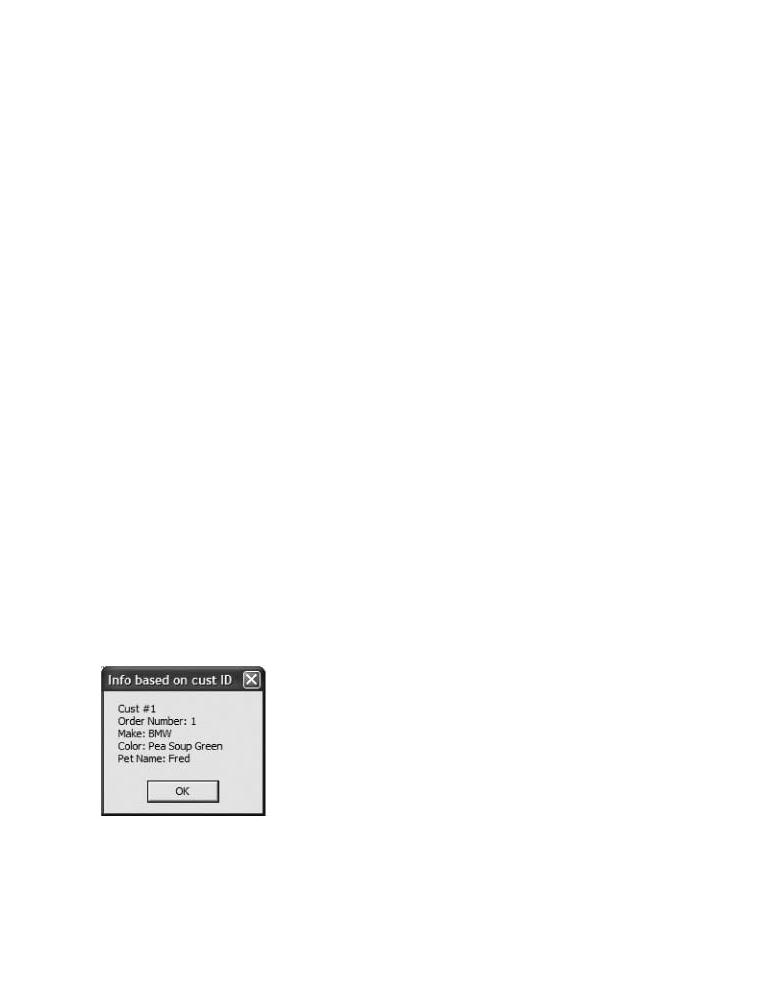
C# and the .NET Platform, Second Edition
Navigating Between Related Tables ISBN:1590590554
by Andrew Troelsen
Apress © 2003 (1200 pages)
To illustrate how a DataRelation allows you to move between related tables, extend your GUI to include a
This comprehensive text starts with a brief overview of the
new Button type and a related TextBox. The end user is able to enter the ID of a customer and obtain all
C# language and then quickly moves to key technical and
the information aboutarchitecturalthat customer'sissues fororder,.NET developerswhich is placed. in a simple message box (Figure 17-17). The Button's Click event handler is as shown here (error checking removed for clarity):
Table of Contents
protected void btnGetInfo_Click (object sender, System.EventArgs e)
C# and the .NET Platform, Second Edition
{
Introduction
string strInfo = "";
Part One - Introducing C# and the .NET Platform
DataRow drCust = null;
Chapter 1 - The Philosophy of .NET
DataRow[] drsOrder = null;
Chapter //2 -GetBuildingtheC#specifiedApplcat ons CustID from the TextBox.
Part Twoint- ThetheCustC# Programm= intg.LanguageParse(this.txtCustID.Text);
Chapter //3 -NowC# Languagebased onFundamentalsCustID, get the correct row in Customers table.
Chapter drCust4 - Object=-OrientedcarsDataSetProgramming.Tables["Customers"]with C# .Rows[theCust];
strInfo += "Cust #" + drCust["CustID"].ToString() + "\n";
Chapter 5 - Exceptions and Object Lifetime
// Navigate from customer table to order table.
Chapter 6 - Interfaces and Collections
drsOrder = drCust.GetChildRows(carsDataSet.Relations["CustomerOrder"]);
Chapter 7 - Callback Interfaces, Delegates, and Events
// Get order number.
Chapter 8 - Advanced C# Type Construction Techniques
foreach(DataRow r in drsOrder)
Part Three - Programming with .NET Assemblies
strInfo += "Order Number: " + r["OrderID"] + "\n";
Chapter 9 - Understanding .NET Assemblies
// Now navigate from order table to inventory table.
Chapter 10 - Processes, AppDomains, Contexts, and Threads
DataRow[] drsInv =
Chapter 11 - Type Reflection, Late Binding, and Attribute-Based Programming drsOrder[0].GetParentRows(carsDataSet.Relations["InventoryOrder"]);
Part Four - Leveraging the .NET Libraries
// Get Car info.
Chapter 12 - Object Serialization and the .NET Remoting Layer foreach(DataRow r in drsInv)
Chapter 13 - Building a Better Window (Introducing Windows Forms)
{
Chapter 14 - A Better Painting Framework (GDI+)
strInfo += "Make: " + r["Make"] + "\n";
Chapter 15 - Programming with Windows Forms Controls
strInfo += "Color: " + r["Color"] + "\n";
Chapter 16 - The System.IO Namespace
strInfo += "Pet Name: " + r["PetName"] + "\n";
Chapter 17 - Data Access with ADO.NET
}
Part FiveMessageBox- Web Applications.Show(strInfo,and XML Web Services"Info based on cust ID");
Chapter} 18 - ASP.NET Web Pages and Web Controls
Chapter 19 - ASP.NET Web Applications
Chapter 20 - XML Web Services
Index
List of
List of
Figure 17-17: Navigating data relations
As you can see, the key to moving between data tables is to use a handful of methods defined by the DataRow type. Let's break this code down step by step. First, you obtain the correct customer ID from the text box and use it to grab the correct row in the Customers table (using the Rows property, of course), as shown here:
// Get the specified CustID from the TextBox.

int theCust = int.Parse(this.txtCustID.Text);
C# and the .NET Platform, Second Edition
// Now based on CustID, get the correct row in the Customers table.
by Andrew Troelsen |
ISBN:1590590554 |
DataRow drCust = null; |
|
Apress © 2003 (1200 pages)
drCust = carsDataSet.Tables["Customers"].Rows[theCust];
This comprehensive text starts with a brief overview of the strInfo += "Cust #" + drCust["CustID"].ToString() + "\n";
C# language and then quickly moves to key technical and
architectural issues for .NET developers.
Next, you navigate from the Customers table to the Orders table, using the CustomerOrder data relation.
Table of Contents
Notice that the DataRow.GetChildRows() method allows you to grab rows from your child table, and once
C# and the .NET Platform, Second Edition
you do, you can read information out of the table, as shown here:
Introduction
Part One - Introducing C# and the .NET Platform
// Navigate from customer table to order table.
Chapter 1 - The Philosophy of .NET
DataRow[] drsOrder = null;
Chapter 2 - Building C# Applications
drsOrder = drCust.GetChildRows(carsDataSet.Relations["CustomerOrder"]);
Part Two - The C# Programming Language
// Get order number.
Chapter 3 - C# Language Fundamentals foreach(DataRow r in drsOrder)
Chapter 4 - Object-Oriented Programming with C#
strInfo += "Order Number: " + r["OrderID"] + "\n";
Chapter 5 - Exceptions and Object Lifetime
Chapter 6 - Interfaces and Collections
ChapterYour final7 step- Callbackis to navigateInterfaces,fromDelegates,the OrdersandtableEventsto its parent table (Inventory), using the
GetParentRows() method. At this point, you can read information from the Inventory table using the Make,
Chapter 8 - Advanced C# Type Construction Techniques
PetName, and Color columns, as shown here:
Part Three - Programming with .NET Assemblies
Chapter 9 - Understanding .NET Assemblies
Chapter// Now10navigate- Process s,fromAppDomains,orderContexts,table andto Threadsinventory table.
ChDataRow[]pter 11 - TypedrsInvReflection,= Late Binding, and Attribute-Based Programming
Part Four drsOrder[0]- Leve aging the.GetParentRows.NET Libraries (carsDataSet.Relations["InventoryOrder"]);
foreach(DataRow r in drsInv)
Chapt r 12 - Object Serialization and the .NET Remoting Layer
{
Chapter 13 - Building a Better Window (Introducing Windows Forms)
strInfo += "Make: " + r["Make"] + "\n";
Chapter 14 - A Better Painting Framework (GDI+)
strInfo += "Color: " + r["Color"] + "\n";
Chapter 15 - Programming with Windows Forms Controls
strInfo += "Pet Name: " + r["PetName"] + "\n";
Chapter 16 - The System.IO Namespace
}
Chapter 17 - Data Access with ADO.NET
Part Five - Web Applications and XML Web Services
Chapter 18 - ASP.NET Web Pages and Web Controls
As a final example of navigating relations programmatically, the following code prints out the values in the
Chapter 19 - ASP.NET Web Applications
Orders table that is obtained indirectly using the InventoryOrders relationship:
Chapter 20 - XML Web Services
Index
protected void btnGetChildRels_Click (object sender, System.EventArgs e)
List of Figures
{
List of Tables
// Ask the CarsDataSet for the child relations of the inv. table.
DataRelationCollection relCol;
DataRow[] arrRows;
string info = "";
relCol = carsDataSet.Tables["inventory"].ChildRelations;
info += "\tRelation is called: " + relCol[0].RelationName + "\n\n";
// Now loop over each relation and print out info.
foreach(DataRelation dr in relCol)
{
foreach(DataRow r in inventoryTable.Rows)
{
arrRows = r.GetChildRows(dr);
// Print out the value of each column in the row.
for (int i = 0; i < arrRows.Length; i++)
{
foreach(DataColumn dc in arrRows[i].Table.Columns)
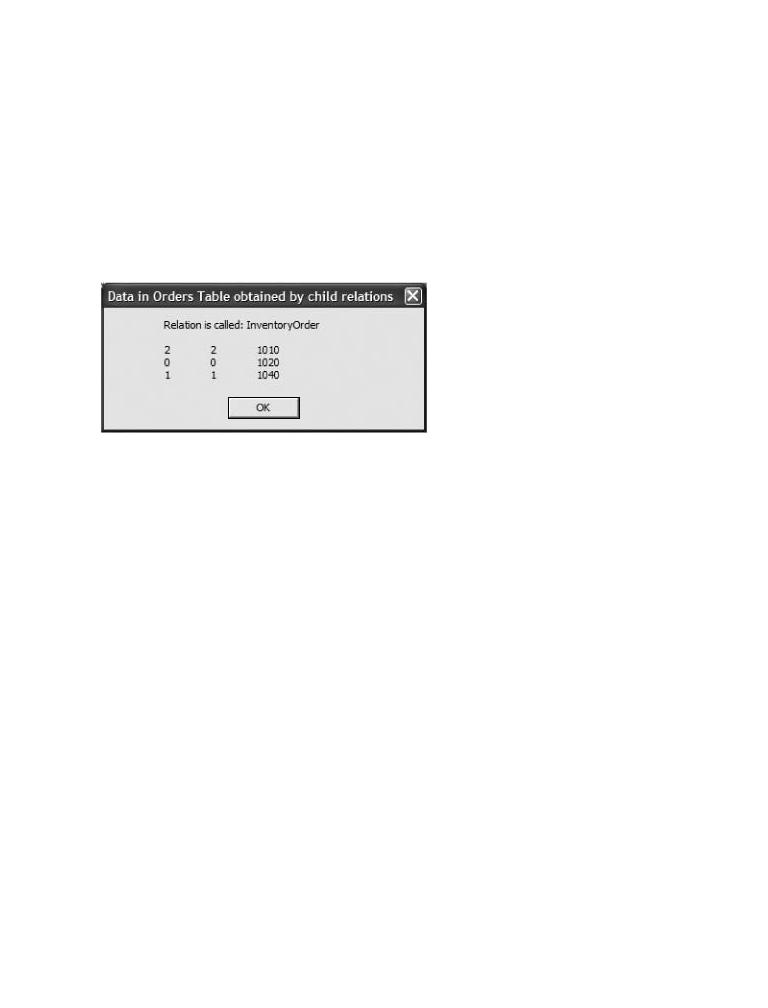
{
C# and the .NET Platform, Second Edition
info += "\t" + arrRows[i][dc];
by Andrew Troelsen |
ISBN:1590590554 |
} |
|
Apress © 2003 (1200 pages) |
|
info += "\n"; |
|
This}comprehensive text starts with a brief overview of the
} C# language and then quickly moves to key technical and
architectural issues for .NET developers.
MessageBox.Show(info,
"Data in Orders Table obtained by child relations");
}
Table of Contents
}
C# and the .NET Platform, Second Edition
Introduction
Part One - Introducing C# and the .NET Platform
Figure 17-18 shows the output.
Chapter 1 - The Philosophy of .NET
Chapter 2 - Building C# Applications
Part
Chapter
Chapter
Chapter
Chapter
Chapter
Chapter
Part
Chapter
Figure 17-18: Navigating parent/child relations
Chapter 10 - Processes, AppDomains, Contexts, and Threads
Chapter 11 - Type Reflection, Late Binding, and Attribute-Based Programming
Hopefully, this last example has you convinced of the usefulness of the DataSet type. Given that a DataSet
Part Four - Leveraging the .NET Libraries
is completely disconnected from the underlying data source, you can work with an in-memory copy of data
Chapter 12 - Object Serialization and the .NET Remoting Layer
and navigate around each table to make any necessary updates, deletes, or inserts. Once this is done,
Chapter 13 - Building a Better Window (Introducing Windows Forms)
you can submit your changes to the data store for processing. Of course you don't yet know how to get
Chapter 14 - A Better Painting Framework (GDI+)
connected! There is one final item of interest regarding the DataSet before addressing this issue.
Chapter 15 - Programming with Windows Forms Controls Chapter 16 - The System.IO Namespace
Chapter 17 - Data Access with ADO.NET
Part Five - Web Applications and XML Web Services
Chapter 18 - ASP.NET Web Pages and Web Controls
Chapter 19 - ASP.NET Web Applications
Chapter 20 - XML Web Services
Index
List of Figures
List of Tables
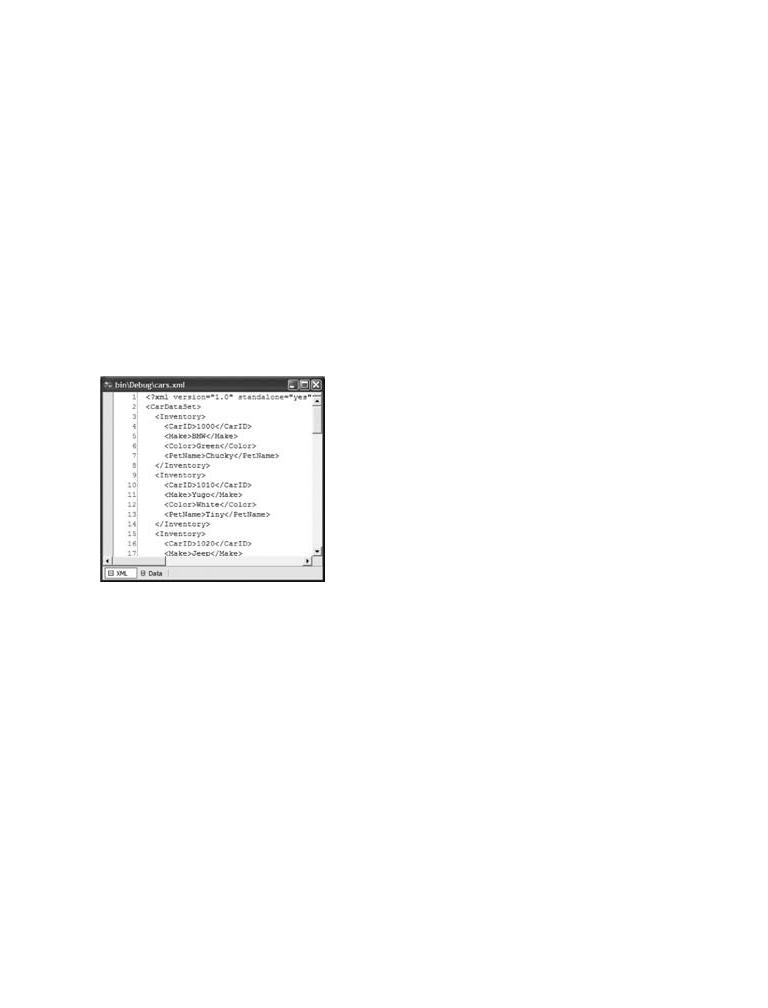
Reading andC# Writingand the .NETXMLPlatform,-BasedS condDataSetsEdition
by Andrew Troelsen |
ISBN:1590590554 |
A major design goal of ADO.NET was to apply a liberal use of XML infrastructure. Using the DataSet type,
Apress © 2003 (1200 pages)
you can write an XML representation of the contents of your tables, relations, and other schematic details
This comprehensive text starts with a brief overview of the
to a given streamC#(suchlanguageas a file)and. Tothendoquicklyso, simplymovescallto thekeyWriteXml()technical andmethod, as shown here:
architectural issues for .NET developers.
protected void btnToXML_Click (object sender, System.EventArgs e)
{
Table of Contents
// Write your entire DataSet to a file in the app directory.
C# and the .NET Platform, Second Edition carsDataSet.WriteXml("cars.xml");
Introduction
MessageBox.Show("Wrote CarDataSet to XML file in app directory");
Part One - Introducing C# and the .NET Platform
btnReadXML.Enabled = true;
Chapter 1 - The Philosophy of .NET
}
Chapter 2 - Building C# Applications
Part Two - The C# Programming Language
Chapter 3 - C# Language Fundamentals
ChapterIf you now4 -openObjectyour-Orientednew fileProgrammingthe VisualwithStudioC# .NET IDE (Figure 17-19), you will see that the entire
DataSet has been transformed to XML.
Chapter 5 - Exceptions and Object Lifetime
Chapter 6 - Interfaces and Collections |
|
Chapter |
and Events |
Chapter |
Techniques |
Part |
|
Chapter |
|
Chapter |
and Threads |
Chapter |
Attribute-Based Programming |
Part |
|
Chapter |
Remoting Layer |
Chapter |
Windows Forms) |
Chapter |
(GDI+) |
Chapter |
Controls |
Chapter |
|
Chapter
Figure 17-19: The Cars database as XML
Part Five - Web Applications and XML Web Services
Chapter 18 - ASP.NET Web Pages and Web Controls
To test the ReadXml() method of the DataSet, perform a little experiment. The CarDataSet application has
Chapter 19 - ASP.NET Web Applications
a Button that will clear out the current DataSet completely (including all tables and relations). After the in-
Chapter 20 - XML Web Services
memory representation has been gutted, instruct the DataSet to read in the cars.xml file, which as you
Index
would guess restores the entire DataSet, as shown here:
List of Figures
List of Tables
protected void btnReadXML_Click (object sender, System.EventArgs e)
{
// Kill current DataSet.
carsDataSet.Clear();
carsDataSet.Dispose();
MessageBox.Show("Just cleared data set..."); carsDataSet = new DataSet("CarDataSet"); carsDataSet.ReadXml("cars.xml");
MessageBox.Show("Reconstructed data set from XML file..."); btnReadXML.Enabled = false;
// Bind to grids.
CarDataGrid.SetDataBinding(carsDataSet, "Inventory");
CustomerDataGrid.SetDataBinding(carsDataSet, "Customers");
}
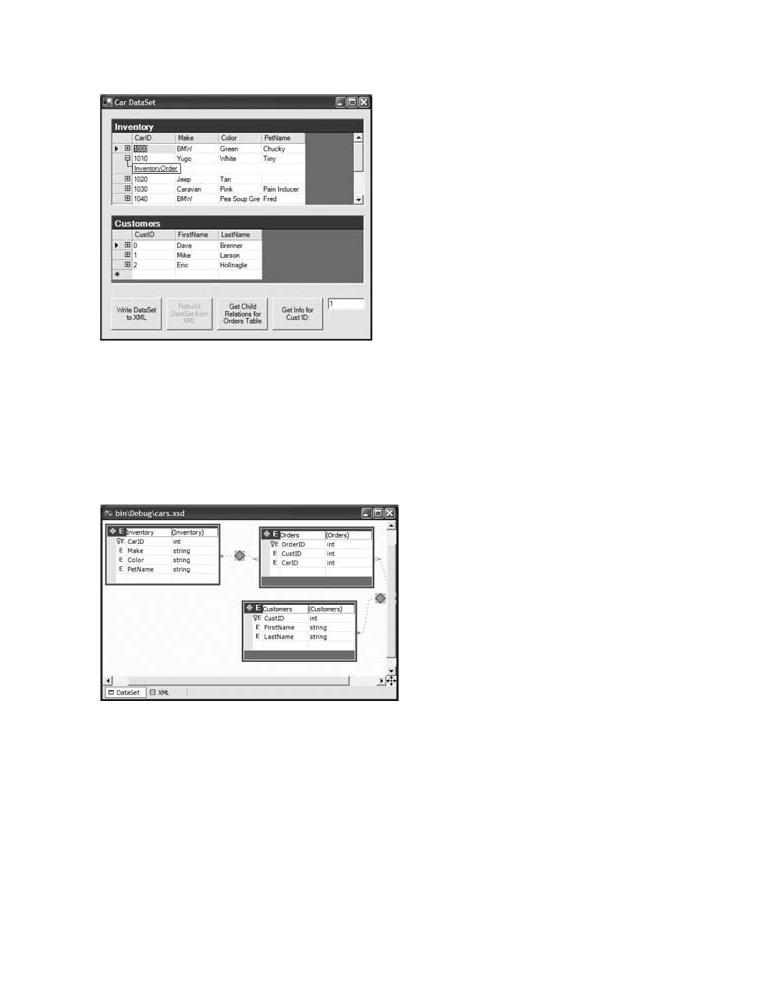
Figure 17-20 shows your final product.
C# and the .NET Platform, Second Edition
by Andrew Troelsen |
ISBN:1590590554 |
a brief overview of the to key technical and
.
Table
C# and
Part
Chapter
Chapter
Part
Chapter
Chapter
Chapter 5 - Exceptions and Object Lifetime
Figure 17-20: The final GUI update
Chapter 6 - Interfaces and Collections
Chapter 7 - Callback Interfaces, Delegates, and Events
In addition to the ability to persist the contents of a DataSet as XML, be aware that the WriteXmlSchema()
Chapter 8 - Advanced C# Type Construction Techniques
and ReadXmlSchema() methods may also be used to generate and read an *.xsd file that represents the
Part Three - Programming with .NET Assemblies
overall structure of the DataSet type. Once you have the data and structure of a DataSet persisted to file,
Chapter 9 - Understanding .NET Assemblies
you are able to manipulate the contents using the types of the System.Xml.dll assembly (see Chapter 18).
Chapter 10 - Processes, AppDomains, Contexts, and Threads
Furthermore, once you have generated your schema file from a given DataSet, you are able to view
Chapter 11 - Type Reflection, Late Binding, and Attribute-Based Programming and/or tweak the type definitions using VS .NET (Figure 17-21).
Part Four - Leveraging the .NET Libraries
Chapter 12 - Object Serialization and the .NET Remoting Layer
Chapter |
Forms) |
Chapter
Chapter
Chapter
Chapter
Part
Chapter
Chapter
Chapter
Index
List of
List of
Figure 17-21: The Cars XML schema file
SOURCE The CarDataSet application is included under the Chapter 17 subdirectory.
CODE

Building a SimpleC# and theTest.NET Platform,DatabaseSecond Edition
by Andrew Troelsen |
ISBN:1590590554 |
Now that you understand how to create and manipulate a DataSet in memory, you can get down to the
Apress © 2003 (1200 pages)
business of making a data connection and seeing how to obtain a populated DataSet from a specific data
This comprehensive text starts with a brief overview of the
provider. In keepingC# withlanguagethe automotiveand then quicklythememovuseds throughouto key technicalthis text,and I have included two versions of a sample Cars databaserchitecturalthat modelsissues thefor .Inventory,NET developersOrders,. and Customers tables examined during the chapter.
TableTheoffirstContentsversion is a SQL script that builds the tables (including their relationships) and is intended for C#usersand oftheSQL.NETServerPlatform,7.0Second(and greater)Edition. To create the Cars database, begin by opening the Query Analyzer
utility that ships with SQL Server. Next, connect to your machine and open the cars.sql file. Before you run
Introduction
the script, be sure that the path listed in the SQL file points to your installation of MS SQL Server. Thus, be
Part One - Introducing C# and the .NET Platform
sure you edit the following DDL (in bold) as necessary (be aware that SQL Server 2000 has a unique
Chapter 1 - The Philosophy of .NET
directory structure. I'm still using SQL 7.0 . . . don't ask):
Chapter 2 - Building C# Applications
Part Two - The C# Programming Language
ChapterCREATE3 DATABASE- C# Language[Cars]FundamentalsON (NAME = N'Cars_Data', FILENAME
=N'C:\MSSQL7\Data \Cars_Data.MDF' ,
Chapter 4 - Object-Oriented Programming with C#
SIZE = 2, FILEGROWTH = 10%)
Chapter 5 - Exceptions and Object Lifetime
Chapter 6 - Interfaces and Collections
LOG ON (NAME = N'Cars_Log', FILENAME
Chapter 7 - Callback Interfaces, Delegates, and Events
= N' C:\MSSQL7\Data\Cars_Log.LDF' ,
Chapter 8 - Advanced C# Type Construction Techniques
SIZE = 1, FILEGROWTH = 10%)
Part Three - Programming with .NET Assemblies
GO
Chapter 9 - Understanding .NET Assemblies
Chapter 10 - Processes, AppDomains, Contexts, and Threads
Chapter 11 - Type Reflection, Late Binding, and Attribute-Based Programming
Now run your script. Once you do, open up the SQL Server Enterprise Manager. You should see the Cars
Part Four - Leveraging the .NET Libraries
database with all three interrelated tables (with some sample data to boot) as well as a single stored
Chapter 12 - Object Serialization and the .NET Remoting Layer
procedure.
Chapter 13 - Building a Better Window (Introducing Windows Forms)
The second version of the Cars database is for users of MS Access. Under the Access DB folder you will
Chapter 14 - A Better Painting Framework (GDI+)
find the cars.mdb file, which contains the same information and underlying structure as the SQL Server
Chapter 15 - Programming with Windows Forms Controls
version. During the remainder of this chapter, I will assume that you are connecting to the SQL Server
Chapter 16 - The System.IO Namespace
Cars database rather than the Access equivalent. In just a bit, however, you will see how to configure an
Chapter 17 - Data Access with ADO.NET
ADO.NET connection object to hook into an *.mdb file.
Part Five - Web Applications and XML Web Services
Chapter 18 - ASP.NET Web Pages and Web Controls
Chapter 19 - ASP.NET Web Applications
Chapter 20 - XML Web Services
Index
List of Figures
List of Tables
